Palm 850 PDA Phone With GSM/GPRS/EDGE and Bluetooth User Manual 1 of 4
Palm Inc PDA Phone With GSM/GPRS/EDGE and Bluetooth 1 of 4
Palm >
Contents
- 1. User Manual 1 of 4
- 2. User Manual 2 of 4
- 3. User Manual 3 of 4
- 4. User Manual 4 of 4
User Manual 1 of 4

Your Palm
®
Treo
™
680
Smart Device
User Guide

Intellectual Property Notices
© 2006 Palm, Inc. All rights reserved. Blazer, HotSync, Palm, Palm
OS, Treo, VersaMail, and the Palm and Treo logos are among the
trademarks or registered trademarks owned by or licensed to Palm,
Inc. This product contains ACCESS Co., Ltd.’s NetFront 3.0 Internet
browser software. © 1996-2005 ACCESS Co., Ltd. and ACCESS
Systems America, Inc. NetFront is the trademark or registered
trademark of ACCESS Co., Ltd. in Japan and in other countries except
the United States of America. NetFront is a registered trademark of
NetFront Communications, Inc. in the United States of America and
is used under a license. Documents To Go is a trademark or
registered trademark of DataViz, Inc. GoodLink is a trademark or
registered trademark of Good Technology, Inc. in the United States
and/or other countries. A portion of the enclosed product is ©
copyrighted by Fraunhofer IIS (2005). All rights reserved. All other
brand and product names are or may be trademarks of, and are used
to identify products or services of, their respective owners.
This product is protected by one or more of the following United
States patents:
7,007,239; 6,976,226; 6,975,304; 6,965,375; 6,961,567; 6,961,029;
6,957,397; 6,952,571; 6,950,988; 6,947,975; 6,947,017; 6,943,667;
6,940,490; 6,924,752; 6,907,233; 6,906,701; 6,906,741; 6,901,276;
6,850,780; 6,845,408; 6,842,628; 6,842,335; 6,831,662; 6,819,552;
6,804,699; 6,795,710; 6,788,285; 6,781,824; 6,781,575; 6,766,490;
6,745,047; 6,744,451; 6,738,852; 6,732,105; 6,724,720; 6,721,892;
6,712,638; 6,708,280; 6,697,639; 6,687,839; 6,685,328; 6,665,803;
6,618,044; 6,590,588; 6,539,476; 6,532,148; 6,523,124; 6,519,141;
6,516,202; 6,490,155; 6,480,146; 6,457,134; 6,456,247; 6,442,637;
6,441,824; 6,437,543; 6,429,625; 6,425,087; 6,389,572; 6,388,877;
6,381,650; 6,363,082; 6,344,848; 6,317,085; 6,241,537; 6,222,857;
6,185,423; 6,147,314; 6,115,248; 6,064,342; D421,251; D429,252;
D466,128; D478,091. Patent pending.
This product also is licensed under United States patent 6,058,304.
A portion of this software includes software modules developed by
the Independent JPEG group. MPEG Layer-3 audio decoding
technology is licensed from Fraunhofer IIS and Thomson. MPEG-4
audio coding technology and advanced video technology licensed by
Fraunhofer IIS.
This product is protected by certain intellectual property rights of
Microsoft. Use or distribution of such technology outside of this
product is prohibited without a license from Microsoft.
Disclaimer and limitation of liability
Palm, Inc. and its suppliers assume no responsibility for any damage
or loss resulting from the use of this guide. Palm, Inc. and its
suppliers assume no responsibility for any loss or claims by third
parties that may arise through the use of this software. Palm, Inc. and
its suppliers assume no responsibility for any damage or loss caused
by deletion of data as a result of malfunction, dead battery, or repairs.
Be sure to make backup copies of all important data on other media
to protect against data loss.
PN: 185-10359-00
v. 1.0

iii
Contents
Welcome . . . . . . . . . . . . . . . . . . . . . . . . . . . . . . . . . . . . . . . . . . . . . . . . . . . . . . . . . . . 1
What do I need to get started? . . . . . . . . . . . . . . . . . . . . . . . . . . . . . . . . . . . . . . . . 3
Chapter 1: Setting up . . . . . . . . . . . . . . . . . . . . . . . . . . . . . . . . . . . . . . . . . . . . . . . . . . 5
Treo 680 overview . . . . . . . . . . . . . . . . . . . . . . . . . . . . . . . . . . . . . . . . . . . . . . . . . . 7
Inserting the SIM card and battery . . . . . . . . . . . . . . . . . . . . . . . . . . . . . . . . . . . . . . 9
Charging the battery . . . . . . . . . . . . . . . . . . . . . . . . . . . . . . . . . . . . . . . . . . . . . . . . . 11
Maximizing battery life . . . . . . . . . . . . . . . . . . . . . . . . . . . . . . . . . . . . . . . . . . . . . . . 13
Making your first call . . . . . . . . . . . . . . . . . . . . . . . . . . . . . . . . . . . . . . . . . . . . . . . . 15
Setting up your computer for synchronization . . . . . . . . . . . . . . . . . . . . . . . . . . . . . 16
Synchronizing information—the basics . . . . . . . . . . . . . . . . . . . . . . . . . . . . . . . . . . 23
Chapter 2: Moving around on your Palm®Treo™ 680 smart device . . . . . . . . . . . . . . 25
Moving around the screen . . . . . . . . . . . . . . . . . . . . . . . . . . . . . . . . . . . . . . . . . . . . 27
Using the keyboard . . . . . . . . . . . . . . . . . . . . . . . . . . . . . . . . . . . . . . . . . . . . . . . . . 31
Opening applications . . . . . . . . . . . . . . . . . . . . . . . . . . . . . . . . . . . . . . . . . . . . . . . . 35
Chapter 3: Your phone . . . . . . . . . . . . . . . . . . . . . . . . . . . . . . . . . . . . . . . . . . . . . . . . . 39
Turning your Treo 680 on and off . . . . . . . . . . . . . . . . . . . . . . . . . . . . . . . . . . . . . . . 41
Making calls . . . . . . . . . . . . . . . . . . . . . . . . . . . . . . . . . . . . . . . . . . . . . . . . . . . . . . . 43
Receiving calls . . . . . . . . . . . . . . . . . . . . . . . . . . . . . . . . . . . . . . . . . . . . . . . . . . . . . 47
Using voicemail . . . . . . . . . . . . . . . . . . . . . . . . . . . . . . . . . . . . . . . . . . . . . . . . . . . . 48
What can I do when I’m on a call? . . . . . . . . . . . . . . . . . . . . . . . . . . . . . . . . . . . . . . 50
How many minutes have I used? . . . . . . . . . . . . . . . . . . . . . . . . . . . . . . . . . . . . . . . 56
Entering names and phone numbers . . . . . . . . . . . . . . . . . . . . . . . . . . . . . . . . . . . . 57
Defining favorite buttons . . . . . . . . . . . . . . . . . . . . . . . . . . . . . . . . . . . . . . . . . . . . . 61
Using a hands-free device . . . . . . . . . . . . . . . . . . . . . . . . . . . . . . . . . . . . . . . . . . . . 64
Customizing phone settings . . . . . . . . . . . . . . . . . . . . . . . . . . . . . . . . . . . . . . . . . . . 69

iv
What are all those icons? . . . . . . . . . . . . . . . . . . . . . . . . . . . . . . . . . . . . . . . . . . . . . 75
Chapter 4: Your email and other messages . . . . . . . . . . . . . . . . . . . . . . . . . . . . . . . . . 79
Which email application should I use? . . . . . . . . . . . . . . . . . . . . . . . . . . . . . . . . . . . 81
The VersaMail application . . . . . . . . . . . . . . . . . . . . . . . . . . . . . . . . . . . . . . . . . . . . 83
Xpress Mail . . . . . . . . . . . . . . . . . . . . . . . . . . . . . . . . . . . . . . . . . . . . . . . . . . . . . . . 96
GoodLink . . . . . . . . . . . . . . . . . . . . . . . . . . . . . . . . . . . . . . . . . . . . . . . . . . . . . . . . . 97
Messaging . . . . . . . . . . . . . . . . . . . . . . . . . . . . . . . . . . . . . . . . . . . . . . . . . . . . . . . . 97
Chapter 5: Your connections to the web and wireless devices . . . . . . . . . . . . . . . . . . 109
Web browser . . . . . . . . . . . . . . . . . . . . . . . . . . . . . . . . . . . . . . . . . . . . . . . . . . . . . . 111
Connecting your computer to the Internet through your Treo . . . . . . . . . . . . . . . . . 119
Connections with Bluetooth devices . . . . . . . . . . . . . . . . . . . . . . . . . . . . . . . . . . . . 122
Chapter 6: Your photos, videos, and music . . . . . . . . . . . . . . . . . . . . . . . . . . . . . . . . . 127
Camera . . . . . . . . . . . . . . . . . . . . . . . . . . . . . . . . . . . . . . . . . . . . . . . . . . . . . . . . . . . 129
Pictures & Videos . . . . . . . . . . . . . . . . . . . . . . . . . . . . . . . . . . . . . . . . . . . . . . . . . . . 133
Pocket Tunes . . . . . . . . . . . . . . . . . . . . . . . . . . . . . . . . . . . . . . . . . . . . . . . . . . . . . . 139
Chapter 7: Your personal information organizer . . . . . . . . . . . . . . . . . . . . . . . . . . . . . . 147
Calendar . . . . . . . . . . . . . . . . . . . . . . . . . . . . . . . . . . . . . . . . . . . . . . . . . . . . . . . . . . 149
World Clock . . . . . . . . . . . . . . . . . . . . . . . . . . . . . . . . . . . . . . . . . . . . . . . . . . . . . . . 156
Tasks . . . . . . . . . . . . . . . . . . . . . . . . . . . . . . . . . . . . . . . . . . . . . . . . . . . . . . . . . . . . 158
Chapter 8: Your memos and documents . . . . . . . . . . . . . . . . . . . . . . . . . . . . . . . . . . . 163
Documents To Go Professional . . . . . . . . . . . . . . . . . . . . . . . . . . . . . . . . . . . . . . . . 165
Memos . . . . . . . . . . . . . . . . . . . . . . . . . . . . . . . . . . . . . . . . . . . . . . . . . . . . . . . . . . . 166
Voice Memo . . . . . . . . . . . . . . . . . . . . . . . . . . . . . . . . . . . . . . . . . . . . . . . . . . . . . . . 167
Chapter 9: Your application and info management tools . . . . . . . . . . . . . . . . . . . . . . . 169
Using Find . . . . . . . . . . . . . . . . . . . . . . . . . . . . . . . . . . . . . . . . . . . . . . . . . . . . . . . . 171
Viewing and using the alerts . . . . . . . . . . . . . . . . . . . . . . . . . . . . . . . . . . . . . . . . . . 171

v
Calculator . . . . . . . . . . . . . . . . . . . . . . . . . . . . . . . . . . . . . . . . . . . . . . . . . . . . . . . . . 172
Installing applications . . . . . . . . . . . . . . . . . . . . . . . . . . . . . . . . . . . . . . . . . . . . . . . . 174
Removing applications . . . . . . . . . . . . . . . . . . . . . . . . . . . . . . . . . . . . . . . . . . . . . . . 176
Viewing application info . . . . . . . . . . . . . . . . . . . . . . . . . . . . . . . . . . . . . . . . . . . . . . 177
Sending information with Bluetooth wireless technology . . . . . . . . . . . . . . . . . . . . 178
Beaming information . . . . . . . . . . . . . . . . . . . . . . . . . . . . . . . . . . . . . . . . . . . . . . . . 180
Synchronizing information—advanced . . . . . . . . . . . . . . . . . . . . . . . . . . . . . . . . . . . 182
Using expansion cards . . . . . . . . . . . . . . . . . . . . . . . . . . . . . . . . . . . . . . . . . . . . . . .188
Chapter 10: Your personal settings . . . . . . . . . . . . . . . . . . . . . . . . . . . . . . . . . . . . . . . 195
System sound settings . . . . . . . . . . . . . . . . . . . . . . . . . . . . . . . . . . . . . . . . . . . . . . . 197
Display and appearance settings . . . . . . . . . . . . . . . . . . . . . . . . . . . . . . . . . . . . . . . 198
Applications settings . . . . . . . . . . . . . . . . . . . . . . . . . . . . . . . . . . . . . . . . . . . . . . . . 201
Locking your Treo and info . . . . . . . . . . . . . . . . . . . . . . . . . . . . . . . . . . . . . . . . . . . . 203
System settings . . . . . . . . . . . . . . . . . . . . . . . . . . . . . . . . . . . . . . . . . . . . . . . . . . . . 210
Connecting to a VPN . . . . . . . . . . . . . . . . . . . . . . . . . . . . . . . . . . . . . . . . . . . . . . . . 212
Chapter 11: Common questions . . . . . . . . . . . . . . . . . . . . . . . . . . . . . . . . . . . . . . . . . 215
Upgrading . . . . . . . . . . . . . . . . . . . . . . . . . . . . . . . . . . . . . . . . . . . . . . . . . . . . . . . . . 217
Desktop software installation . . . . . . . . . . . . . . . . . . . . . . . . . . . . . . . . . . . . . . . . . . 219
Resetting your Treo . . . . . . . . . . . . . . . . . . . . . . . . . . . . . . . . . . . . . . . . . . . . . . . . . 219
Replacing the battery . . . . . . . . . . . . . . . . . . . . . . . . . . . . . . . . . . . . . . . . . . . . . . . . 221
Screen . . . . . . . . . . . . . . . . . . . . . . . . . . . . . . . . . . . . . . . . . . . . . . . . . . . . . . . . . . . 223
Synchronization . . . . . . . . . . . . . . . . . . . . . . . . . . . . . . . . . . . . . . . . . . . . . . . . . . . . 224
Phone . . . . . . . . . . . . . . . . . . . . . . . . . . . . . . . . . . . . . . . . . . . . . . . . . . . . . . . . . . . . 231
Hands-free devices . . . . . . . . . . . . . . . . . . . . . . . . . . . . . . . . . . . . . . . . . . . . . . . . . . 233
Email . . . . . . . . . . . . . . . . . . . . . . . . . . . . . . . . . . . . . . . . . . . . . . . . . . . . . . . . . . . . . 234
Messaging . . . . . . . . . . . . . . . . . . . . . . . . . . . . . . . . . . . . . . . . . . . . . . . . . . . . . . . . 234
Web . . . . . . . . . . . . . . . . . . . . . . . . . . . . . . . . . . . . . . . . . . . . . . . . . . . . . . . . . . . . . 236
Camera . . . . . . . . . . . . . . . . . . . . . . . . . . . . . . . . . . . . . . . . . . . . . . . . . . . . . . . . . . . 239

vi
Making room on your Treo . . . . . . . . . . . . . . . . . . . . . . . . . . . . . . . . . . . . . . . . . . . . 240
Third-party applications . . . . . . . . . . . . . . . . . . . . . . . . . . . . . . . . . . . . . . . . . . . . . . 241
Error messages . . . . . . . . . . . . . . . . . . . . . . . . . . . . . . . . . . . . . . . . . . . . . . . . . . . . 242
Where to learn more . . . . . . . . . . . . . . . . . . . . . . . . . . . . . . . . . . . . . . . . . . . . . . . . . . 245
Terms . . . . . . . . . . . . . . . . . . . . . . . . . . . . . . . . . . . . . . . . . . . . . . . . . . . . . . . . . . . . . . 247
Regulatory information . . . . . . . . . . . . . . . . . . . . . . . . . . . . . . . . . . . . . . . . . . . . . . . . . 251
Specifications . . . . . . . . . . . . . . . . . . . . . . . . . . . . . . . . . . . . . . . . . . . . . . . . . . . . . . . . 263
Index . . . . . . . . . . . . . . . . . . . . . . . . . . . . . . . . . . . . . . . . . . . . . . . . . . . . . . . . . . . . . . 267

WELCOME 1
Welcome
Congratulations on the purchase of your
Palm®Treo™ 680 smart device! In one
compact and indispensable device, you
now have all of the following:
•Contacts application that stores the
names, phone numbers, and even
pictures of friends, family, business
contacts—everyone you stay in touch
with
•Email applications for receiving and
sending email (business and personal)
•Palm OS® personal info applications for
storing your appointments, to-do lists,
memos, and more
•Expansion card slot that accepts cards
(MultiMediaCard/SD/SDIO; sold
separately) for storing music files,
videos, dictionaries, games, and lots of
other applications
•A VGA (640x480) digital camera for
snapping photos and capturing short
videos (camera version only)
•Text and multimedia messaging
•MP3 player
•Applications for reading, creating, and
editing Microsoft Office files and
viewing PDF files
•Software for entering names,
addresses, and more on your computer,
and then transferring them to your Treo
680 with one press of a button
NOTE Phone and text messaging services
require a service contract with Cingular
Wireless. Web, email, and multimedia
messaging services require a service
contract and data services from Cingular
Wireless. Data speeds vary based on
network availability and capacity.
DID
YOU
KNOW
?
The Cingular Wireless
business-to-business sales channel offers a
Treo 680 without a camera. If you purchased
your Treo 680 from this channel, check the
packaging to see if it includes a camera.

WELCOME
2
What’s in the box?
You should have received all the following
items in the box:
Hardware
•Treo 680
•Cingular Wireless SIM card (not
included with all models; preinstalled in
Treo 680 on some models; see Inserting
the SIM card and battery for details)
•Rechargeable battery
•AC charger
•USB sync cable
•Headset
Documentation and software
•Getting Started Guide
•Palm Software Installation CD, which
includes the following:
•Palm®Desktop software
•Bonus software for your Treo 680
•Your Palm Treo 680 Smart Device
User Guide (this guide)
•Palm warranty
KEY
TERM
SIM (Subscriber Identity Module)
card The smartcard that you insert into your
Treo 680 and identifies you to the mobile
network. It contains your mobile account
information, such as your phone number and
the services to which you subscribe. Phone
book entries and SMS messages can also be
stored on the SIM card.
TIP
Missing something or need help? Contact
Cingular Wireless customer service:
1-866-CINGULAR (1-866-246-4852) or call 611
from your mobile phone.

WELCOME 3
What do I need to
get started?
This guide helps you set up your and
quickly learn to use it. To get started, you
need all the items that came in the Treo
680 box (see What’s in the box? ), plus the
following:
•A SIM card. If your Treo 680 box did not
contain a SIM card, you need to contact
Cingular Wireless to get one. Be sure to
sign up for a mobile account with data
services. To use your Treo 680 on the
Cingular Wireless network, the SIM
card must be inserted into your Treo
680. Without a SIM card, you can only
call 911.
•You must be in a location where you are
within coverage of the Cingular
Wireless network.
•An electrical outlet
•The computer with which you want to
synchronize your personal information
NOTE To use email, web browsing, and
multimedia messaging, your Cingular
Wireless service plan must include data
services. Please contact Cingular Wireless
for details about your data service options.

WELCOME
4

CHAPTER
1
Setting up
Congratulations on the purchase of your new Palm®Treo™ 680
smart device. You’re about to discover the many things about
your Treo 680 that will help you better manage your life and
have fun, too.
As you become more familiar with your Treo 680, you’ll want to
personalize the settings and add applications to make it
uniquely yours. But first, take these few easy steps to set up
your Treo 680 and get it running.
Benefits
•Know where your Treo 680
controls are located
•Start using your Treo 680 right
away
•Establish a link between your Treo
680 and your computer

In this chapter
Treo 680 overview . . . . . . . . . . . . . . . . . . . . . . . . . . . . . . . . . . . . . . 7
Inserting the SIM card and battery. . . . . . . . . . . . . . . . . . . . . . . . . . 9
Charging the battery. . . . . . . . . . . . . . . . . . . . . . . . . . . . . . . . . . . . . 11
Maximizing battery life. . . . . . . . . . . . . . . . . . . . . . . . . . . . . . . . . . . 13
Making your first call . . . . . . . . . . . . . . . . . . . . . . . . . . . . . . . . . . . . 15
Setting up your computer for synchronization . . . . . . . . . . . . . . . . . 16
Synchronizing information—the basics . . . . . . . . . . . . . . . . . . . . . . 23
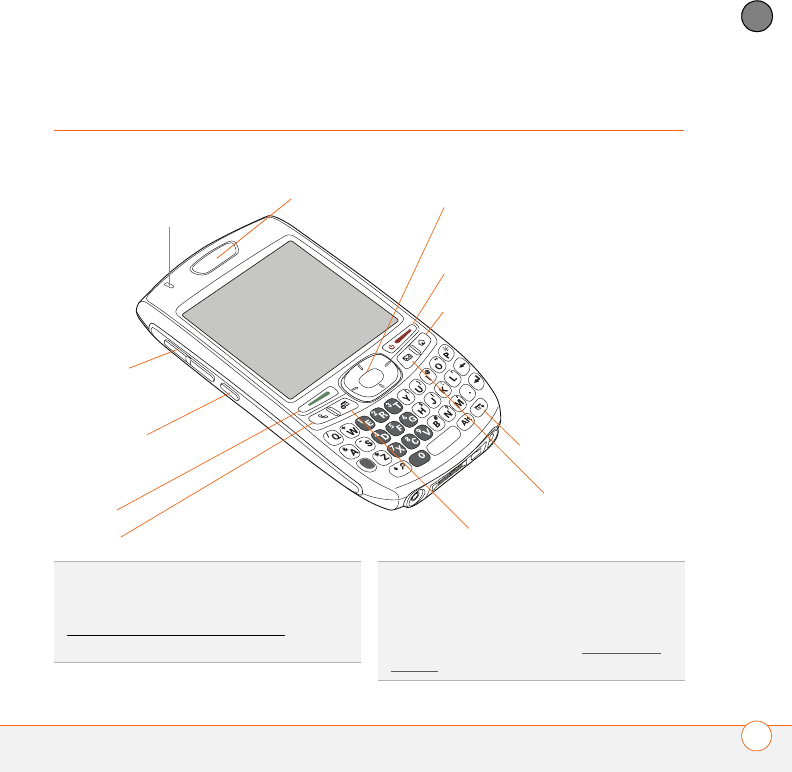
SETTING UP
7
1
CHAPTER
Treo 680 overview
Front view
Indicator light (phone
and charge indicator)
Calendar
5-way navigator and
Center button
Earpiece
Menu
Send
Phone
Side button
Volume
Power/End
Messaging
Applications
TIP
Protect your screen. Be careful to store
your Treo 680 away from items that might
scratch or crush the screen. Visit
www.palm.com/mytreo680cingular to find
carrying cases and other useful accessories.
DID
YOU
KNOW
?
When your Treo 680 screen is
on, you can press and hold the Side button to
open the Voice Memo application. You can
also change your button settings and select an
application of your choice; see Reassigning
buttons for details.
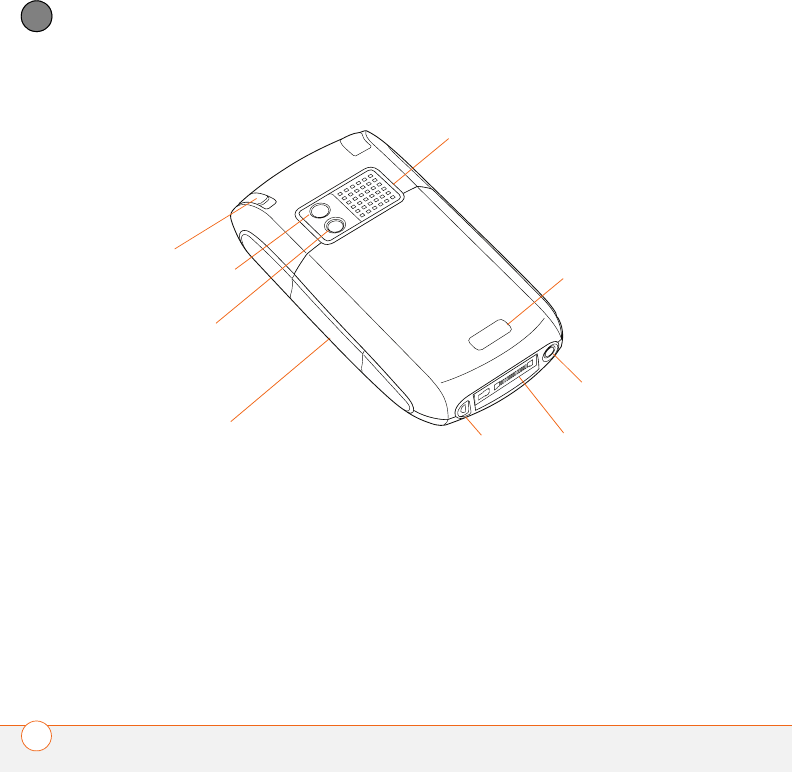
SETTING UP
8
1
CHAPTER
Back view
IMPORTANT The Treo 680 speaker
includes a large magnet, so be sure to
keep your Treo 680 away from credit cards
or other items that could be demagnetized.
Camera lens
(camera version
only)
Battery door
release
Speaker
Self-portrait mirror
(camera version
only)
Multi-connector
Headset jack
Microphone
Expansion slot door
Stylus
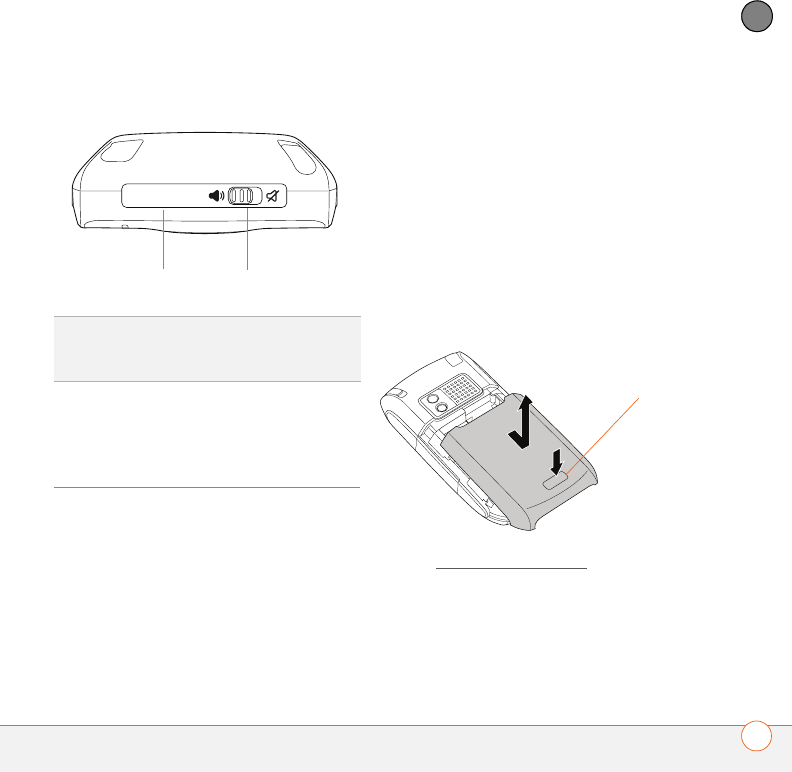
SETTING UP
9
1
CHAPTER
Top view
Inserting the SIM
card and battery
Your SIM card contains account
information such as your phone number
and voicemail access number. To use the
phone, email, or web features, the SIM
card must be inserted in your Treo 680.
NOTE Your SIM card may already be
installed in your Treo 680. Follow steps 1–3
to check. If a SIM card did not come with
your Treo 680, you may already have one;
otherwise, Cingular Wireless will give you
one when you subscribe.
1Use one hand to press the Battery
door release button and use your other
hand to slide the battery door
downward to remove it from your Treo
680.
2If the battery is installed, remove it.
(See Replacing the battery for details.)
3Slide the SIM tray out of the slot inside
the Treo 680. If the SIM card is already
installed, skip to step 6.
DID
YOU
KNOW
?
The Ringer switch silences all
sounds at once. You don’t need to hunt for Off
buttons all over the device.
Ringer switchInfrared (IR) port
Battery door
release
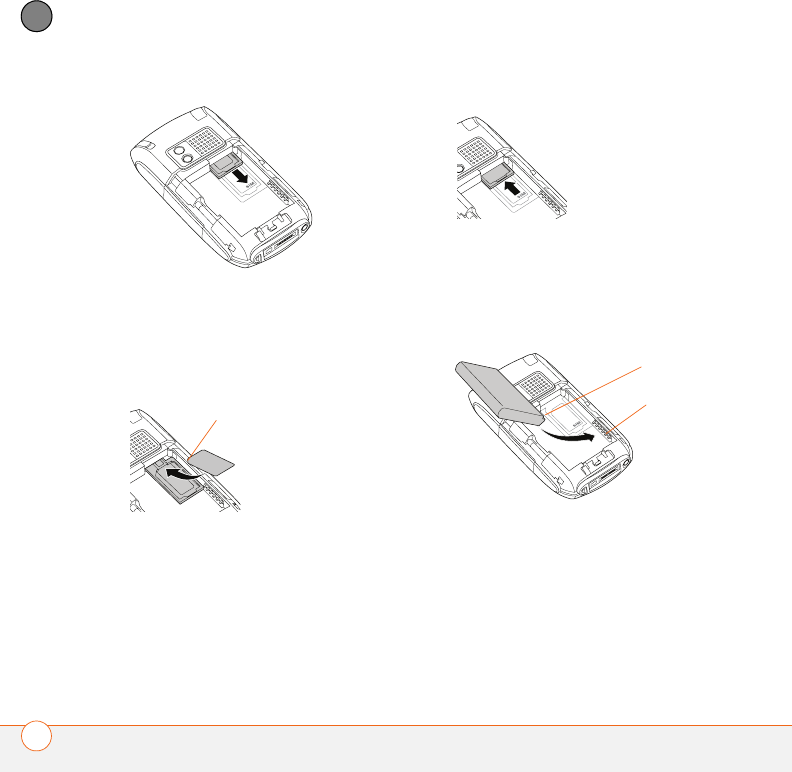
SETTING UP
10
1
CHAPTER
4Align the notch on the SIM card with
the notch in the SIM tray. Insert the
notched end of the SIM card into the
SIM tray, and then press the other end
of the card until it falls into place.
5Slide the SIM tray back into the slot
inside the Treo 680.
6Align the metal contacts on the battery
with the contacts inside the battery
compartment, insert the battery into the
compartment at a 45-degree angle, and
then press it into place.
IMPORTANT Use the battery that came
with your Treo 680. Do not use a battery
from another Treo model in your Treo 680.
Similarly, do not use the Treo 680 battery in
another Treo model. Using a battery that is
designed for another Treo model can
damage your Treo 680. For info on
Notch
Battery
contacts
Treo 680
contacts

SETTING UP
11
1
CHAPTER
replacement batteries, see Replacing the
battery.
7Slide the battery door onto the back of
the Treo 680 until it clicks into place.
8Your Treo screen wakes up and begins
the setup process. When the language
selection screen appears, select the
language you want to use, and then
follow the onscreen instructions to set
up your Treo.
IMPORTANT Always use the same
language for your Treo, your computer
operating system, and your desktop
software. Otherwise, you may lose
information or have difficulty with
synchronization. Support is not provided for
mismatched language setups.
Charging the battery
The battery comes with a sufficient charge
to complete the setup process and activate
your phone. After activation, we
recommend charging your Treo 680 for
three hours (or until the indicator light is
solid green) to give it a full charge. See
Maximizing battery life for tips on
maximizing the life of your Treo battery.
TIP
If your Treo does not turn on, you need to
connect it to the AC charger. If it still does not
turn on after being connected to the AC
charger for five minutes, then do a soft reset.
See Performing a soft reset.
TIP
The power-saving feature turns off the Treo
screen after a period of inactivity. To wake up
the screen, press and release Power/End,
and then press Center on the 5-way to turn off
Keyguard.
TIP
To avoid draining the battery, charge your
Treo 680 every day, especially if you use your
phone often.
DID
YOU
KNOW
?
If your battery ever becomes
fully drained, your info is still stored safely on
your Treo 680 until you recharge the battery or
connect your Treo 680 to a power source.
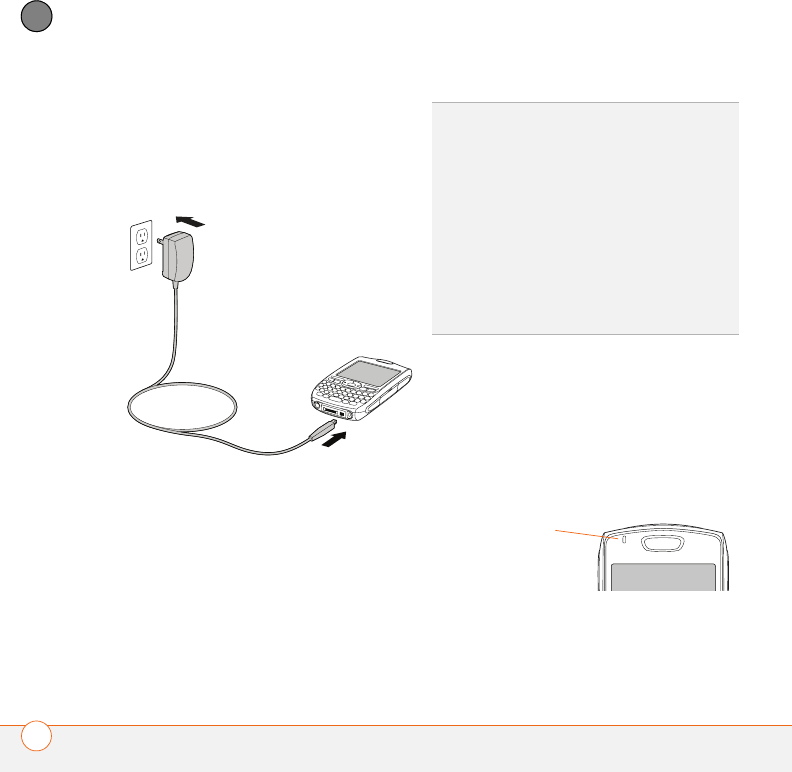
SETTING UP
12
1
CHAPTER
1Plug the AC charger into a wall outlet.
2Connect the charger cable to the
bottom of your Treo 680. Make sure the
arrow on the connector is facing up,
toward the screen.
3To confirm that your Treo 680 is
charging, check the indicator light on
your Treo 680.
•Solid red indicates that your Treo 680
is charging.
•Solid green indicates that your Treo
680 is fully charged.
DID
YOU
KNOW
?
You can also trickle charge your
Treo 680 without the AC charger by
connecting it to your computer with the sync
cable. However, it takes longer to charge the
battery without the AC charger, and if your
laptop isn’t plugged into a power source, it can
drain the laptop’s battery. For the quickest
charge time, use the AC charger.
TIP
When trickle charging your Treo 680 with
the sync cable, the indicator light may not turn
on. To make sure the battery is charging,
check the onscreen battery indicator.
Indicator light
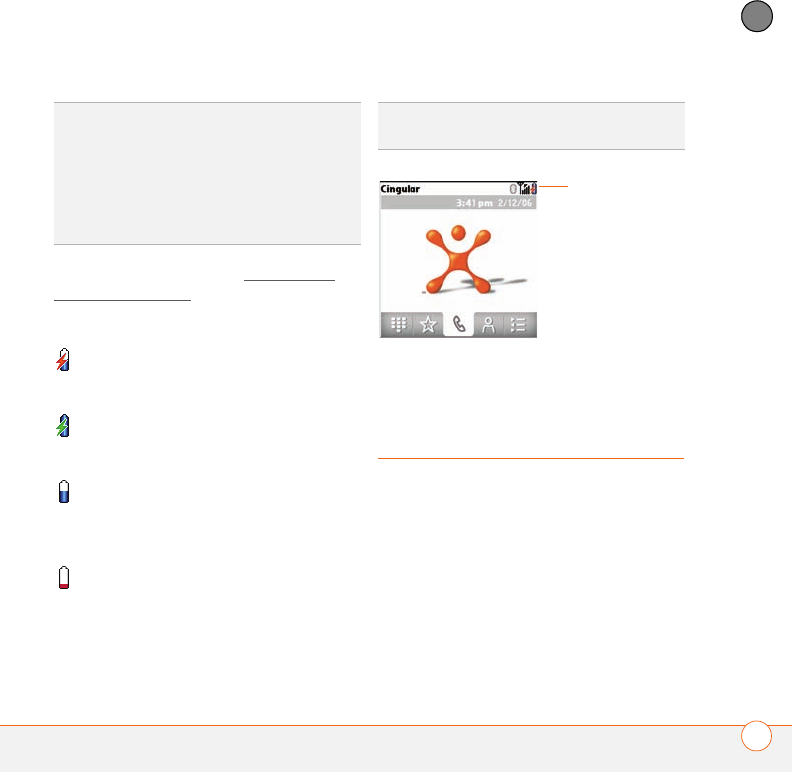
SETTING UP
13
1
CHAPTER
When your Treo is on (see Turning your
Treo 680 on and off), the onscreen battery
icon displays the charging status:
Maximizing battery
life
Battery life depends on how you use your
Treo 680. You can maximize the life of your
battery by following a few easy guidelines:
IMPORTANT Use the battery that came
with your Treo 680. Do not use a battery
from another Treo in your Treo 680.
Similarly, do not use the Treo 680 battery in
another Treo. Using a battery that is
designed for another Treo can damage your
TIP
If the battery is fully drained, it may take a
few moments for the indicator light to turn on
when you begin charging.
TIP
If the indicator light does not turn on when
you connect your Treo 680 to the AC charger,
double-check the cable connection and the
electrical outlet to which it is connected.
A red lightning bolt indicates that
the battery is connected to a wall
outlet and is charging.
A green lightning bolt indicates that
the battery is connected to a wall
outlet and is fully charged.
A partial battery without a lightning
bolt indicates that the battery is not
connected to a wall outlet and it
has some power.
An almost empty battery that is red
at the bottom indicates that you
need to charge the battery
immediately.
TIP
To see exactly how much power is left in
your battery, tap the onscreen battery icon.
Battery icon

SETTING UP
14
1
CHAPTER
Treo 680. For info on replacement
batteries, see Replacing the battery.
•Charge your Treo 680 whenever you
can. Charge it overnight. The battery
has a much longer useful life when it is
topped off frequently, rather than
charging it after it is fully drained.
•The wireless features (phone, email,
messaging, and web) and media
features (camera, media players,
eBooks, and games) of your Treo 680
consume more power than its organizer
features. Speakerphone usage also
consumes more power than using the
earpiece. If you use the wireless,
speakerphone, and media features
often, keep an eye on the battery icon
and charge when necessary.
•If you don’t plan to use the wireless
features on your Treo for a while, turn
off your phone (see Turning your phone
on and off) and let all calls be picked up
by voicemail.
•As with any mobile phone, if you are in
an area with no wireless coverage, your
Treo searches for a signal, which
consumes power. If you cannot move to
an area of better coverage, temporarily
turn off your phone. While your phone is
off, you can continue to use the
nonwireless features of your Treo.
•Turn down the screen brightness (see
Adjusting the brightness).
•Decrease the settings in Power
Preferences and turn off Beam Receive
(see Optimizing power settings).
•Turn off the Bluetooth® feature if you’re
not using it. See Connecting to a
Bluetooth hands-free device.
TIP
You can buy an extra battery as a spare for
long airplane trips or periods of heavy use. To
purchase batteries that are compatible with
your Treo 680, go to www.palm.com/
mytreo680cingular.
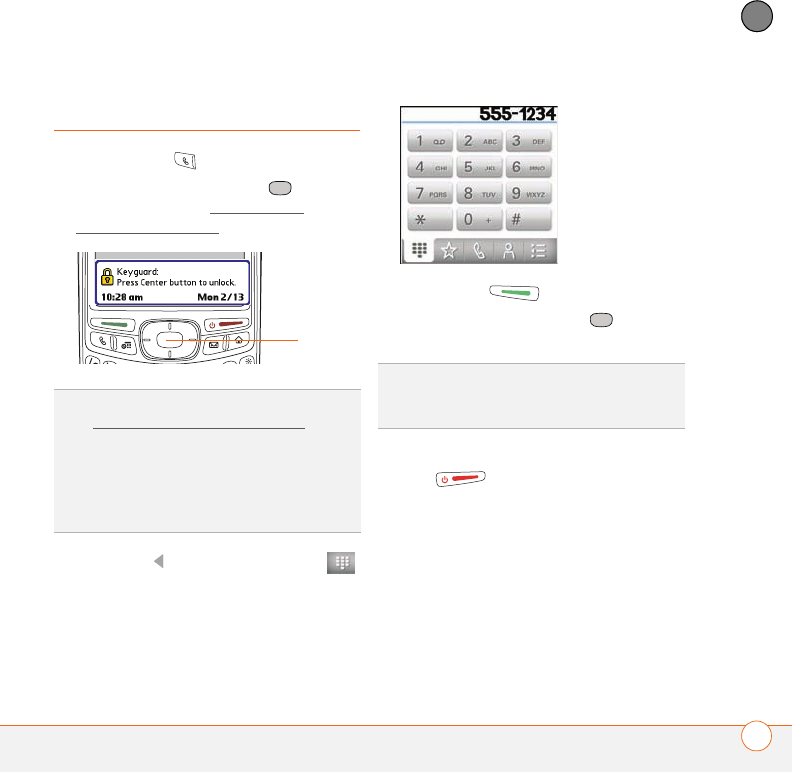
SETTING UP
15
1
CHAPTER
Making your first call
1Press Phone .
2If prompted, press Center to turn
off Keyguard (see Locking your
keyboard (Keyguard) for more info).
3Press Left to select the Dial Pad
tab.
4Tap the onscreen Dial Pad to enter the
number you want to call.
5Press Send to dial the number.
6If prompted, press Center to select
Ye s and turn on your phone.
7After you finish the call, press Power/
End to end the call.
Adjusting call volume
While a call is in progress, press the
Vol ume button on the side of your Treo
680 to adjust the call volume.
•To increase the volume, press the upper
half of the Volu me button.
TIP
If Check SIM Card appears in the title bar,
see Inserting the SIM card and battery.
TIP
If No Service appears in the title bar,
you’re outside a wireless coverage area. If you
believe you are in a wireless coverage area
and this problem persists, contact Cingular
Wireless for assistance.
Center
TIP
If you are inside a coverage area and
cannot complete a call, contact Cingular
Wireless for assistance.
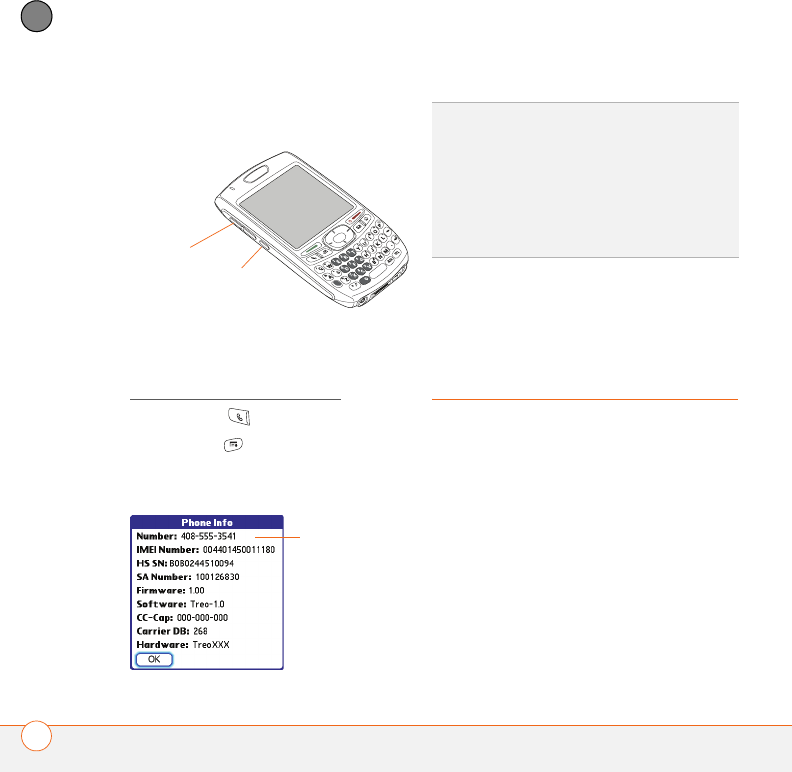
SETTING UP
16
1
CHAPTER
•To decrease the volume, press the
lower half of the Vol ume button.
What’s my phone number?
1Make sure your phone is on (see
Turning your phone on and off).
2Press Phone .
3Press Menu .
4Select Options, and then select Phone
Info.
Setting up your
computer for
synchronization
Why set up a connection between your
Treo 680 and your computer? So you can
synchronize. Why synchronize? Here are
two good reasons:
•It’s easier to enter names, phone
numbers, and addresses using the big
keyboard on your computer than the
keyboard on your Treo 680. Whether
you enter or change information on your
computer (using Palm®Desktop
software or Microsoft Outlook for
Windows) or on your Treo 680, you
Volume
Side button
Look here for
your phone
number
TIP
If your phone number doesn’t appear in
Phone Info, make sure your SIM card is
properly inserted in your Treo 680. If your
phone number still does not appear in Phone
Info, look for the number on the plastic holder
to which the SIM card was attached. If you
still need assistance, please contact Cingular
Wireless.

SETTING UP
17
1
CHAPTER
automatically update the info in both
places when you synchronize. So
there’s no need to enter the info twice.
•You have a backup copy of all your info.
Should anything happen to your Treo
680, your info still exists on your
computer.
We strongly recommend that you
synchronize your Treo 680 with your
computer frequently to keep your
information up-to-date (and backed up) in
both locations.
Before you can synchronize, you need to
install the desktop synchronization
software and connect the sync cable to
your computer.
System requirements
Your computer should meet the following
minimum system profiles for Windows or
Mac computers:
•Windows 2000 or XP (or later)
•32MB of available memory (RAM)
•170MB of free hard disk space
•CD drive
•Available USB port
•Mac OS X version 10.2 or later
•128MB of total memory (RAM)
•190MB of free hard disk space
•CD drive
•Available USB port
Upgrading from another Palm OS®device
NOTE If you are setting up your first Palm
OS® device, skip ahead to Installing the
desktop synchronization software.
You can transfer all compatible applications
and information from your previous Palm
OS device—whether it’s a handheld or a
Treo— to your new Treo 680, so long as the
space taken up by all the info you want to
transfer is 64MB or less. This includes your
calendar events, contacts, memos, and
tasks, as well as your application settings
and any compatible third-party applications
and files.
When you install the desktop software
from the Palm Software Installation CD,
some third-party applications may be
quarantined because they are not
compatible with the Palm OS software
version 5.4.9 on your Treo 680.
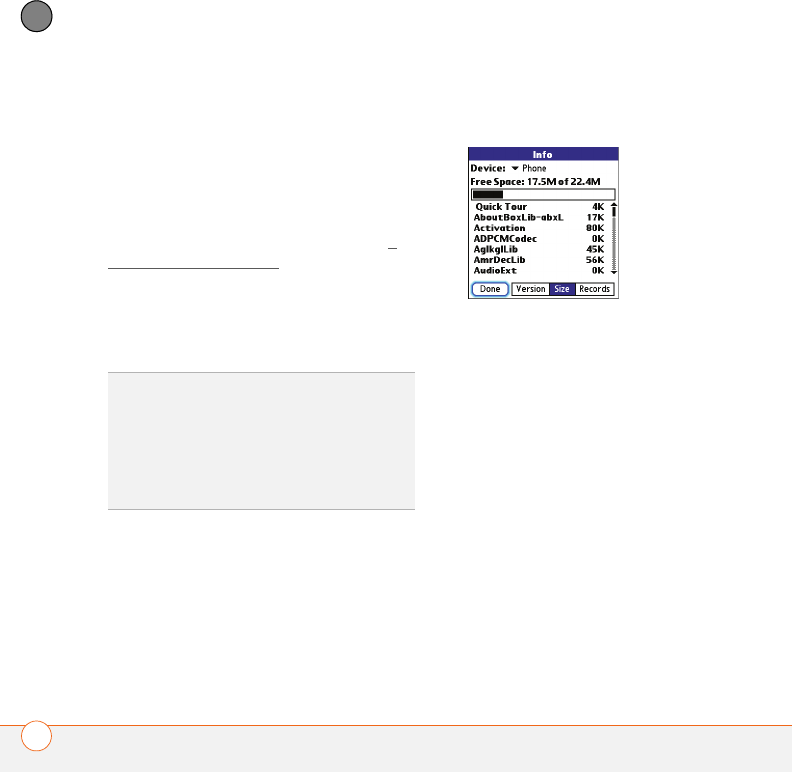
SETTING UP
18
1
CHAPTER
Quarantined files are not installed on your
Treo 680, nor are they deleted; these files
are placed in a new folder on your
computer: C:\Program Files\Palm\<device
name>\PalmOS5 Incompatible Apps.
(Can’t find a Palm folder in Program Files?
Then look for a folder labeled palmOne or
Handspring instead. For more info, see I
can’t find my user folder.)
IMPORTANT Do not synchronize your Treo
680 with any previous versions of
Palm Desktop software.
1Calculate how much space your apps
and info occupy on your previous Palm
OS device:
•In Applications View, open the menus.
•Select Info on the App menu.
•At the bottom of the screen, select
Size.
•Look at the numbers on the Free
Space line and subtract the number
on the left from the number on the
right to calculate the space used. For
example, on the device shown here,
22.4 – 17.5 = 4.9. This means that
4.9MB of space is occupied on this
device.
2If the space occupied on your previous
device is 64MB or less, then go to step
3. If the space occupied is greater than
64MB, then do any of the following to
reduce the storage space you’re using
before you go to the next step:
•Delete any third-party applications
that you no longer use.
TIP
We do not recommend using third-party
utilities that back up your old device’s
information onto an expansion card and then
transfer the info to your Treo 680. Such
methods transfer all applications to your Treo
680, including ones that are not designed to
work with Palm OS version 5.4.9.

SETTING UP
19
1
CHAPTER
•Move large files, such as eBooks and
images, to an expansion card.
•Move third-party applications to an
expansion card.
•Purge old info in applications such as
Calendar (Date Book), Tasks (To Do),
and email. Refer to the
documentation that came with your
previous device for instructions on
these items.
3Synchronize your previous device with
your previous desktop software to back
up your information one last time.
4Install the desktop synchronization
software from your new Palm Software
Installation CD (see Installing the
desktop synchronization software).
5During the installation process, sync
your Treo 680 with your new desktop
software as instructed. When
prompted, do the following:
•Connect your Treo 680 to your
computer (see Connecting your Treo
680 to your computer).
•Indicate whether you want to sync
only the info in your PIM apps
(Calendar, Contacts, Memos, and
Tasks) or all info and apps (excluding
apps known to be incompatible).
•Select a device name for your Treo
680; be sure to select the same name
that you used for your old device.
(This is the name that appears in the
User list in Palm Desktop software.)
6MAC ONLY If you have pictures on
your previous device, copy them from
your previous device to an expansion
card or beam them to your Treo 680.
7If you plan to continue using your
previous device, perform a hard reset
on your previous device to remove its
associated device name. (See the
documentation that came with your
previous device for instructions on
performing a hard reset.) Each device
you synchronize with your computer
must have a unique name. The next
time you synchronize your previous
device with your computer, be sure to
assign it a new name.
If any third-party applications are
quarantined during the installation, do not
manually install them. Contact the
third-party developer for software updates
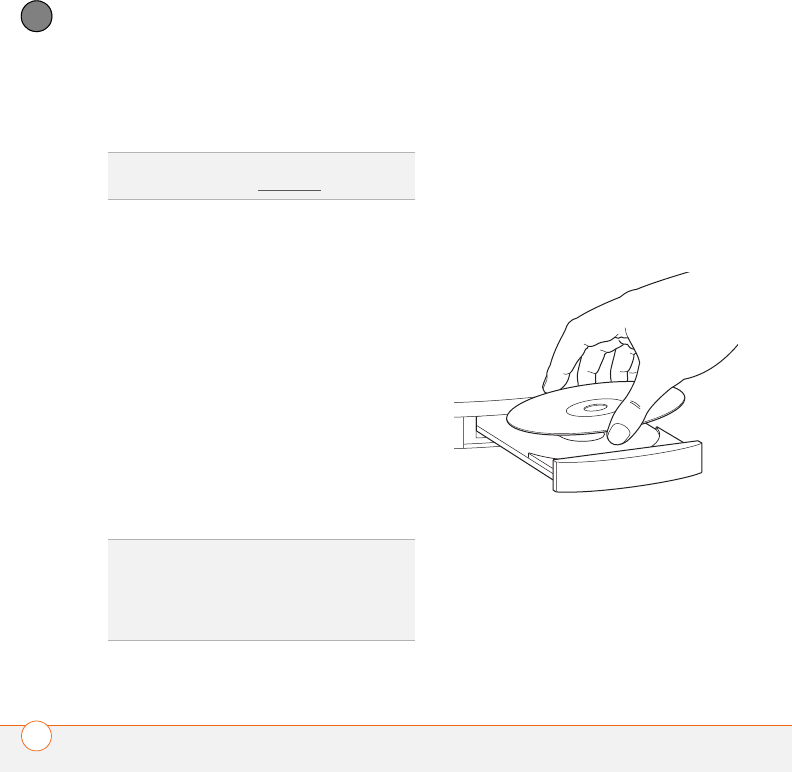
SETTING UP
20
1
CHAPTER
and info about compatibility with your Treo
680.
Installing the desktop synchronization
software
IMPORTANT Even if you already own a
Palm OS device and have installed a
previous version of the desktop software,
you must install the software from the
Palm Software Installation CD that came
with your Treo 680.
BEFORE YOU BEGIN If you are installing
on a computer at work, make sure your
computer is configured to let you install
new software. Contact your company’s
IT department for help.
1Close any applications that are currently
running on your computer, including
those that are minimized. Your
computer needs to have all its
resources available to install the
software.
2Insert the Palm Software Installation CD
into the CD drive on your computer.
3If you are installing on a Mac,
double-click the CD icon on the desktop,
and then double-click the
PalmSoftware.pkg icon.
4When the installation wizard opens,
follow the onscreen instructions. Please
TIP
If you have trouble upgrading or finding
quarantined files, see Upgrading.
TIP
If you want to sync info with applications
other than Palm Desktop or Microsoft
Outlook, you need to purchase additional
third-party sync software. This sync software
is sometimes called a conduit.

SETTING UP
21
1
CHAPTER
note these important points about the
installation process:
•When the language selection screen
appears, select the same language
you selected on your Treo 680.
•WINDOWS ONLY You can choose
which desktop software you want to
use for synchronization:
Palm Desktop software or Microsoft
Outlook.
NOTE Whether you select to synchronize
with Microsoft Outlook or Palm Desktop
software, Palm Desktop software is still
installed on your computer. If you use
Outlook as your desktop email application,
select Outlook as your desktop
synchronization software. Remember that
when you enter information on your
computer, enter it in the software you
selected in this step.
•The install process prompts you to
connect your Treo 680 to your
computer. Go to the next section.
0
Connecting your Treo 680 to your
computer
After you install the desktop software (see
Installing the desktop synchronization
software), you’re ready to connect your
Treo 680 to your computer.
BEFORE YOU BEGIN To set up your
computer, you need the sync cable that
came with your Treo 680.
1Plug the AC charger into a wall outlet.
2Plug the USB sync cable into an
available USB port or a powered USB
hub on your computer.
3With the sync button facing up, connect
the sync cable to the bottom of your
Treo 680. Do not press the sync button
until you are instructed to do so.
TIP
For best performance, plug your sync
cable directly into a USB port on your
computer. If your computer has USB ports on
both the front and back, we suggest using the
back port; the front port is often a low-power
port. If you use a USB hub, make sure the hub
has its own power supply.
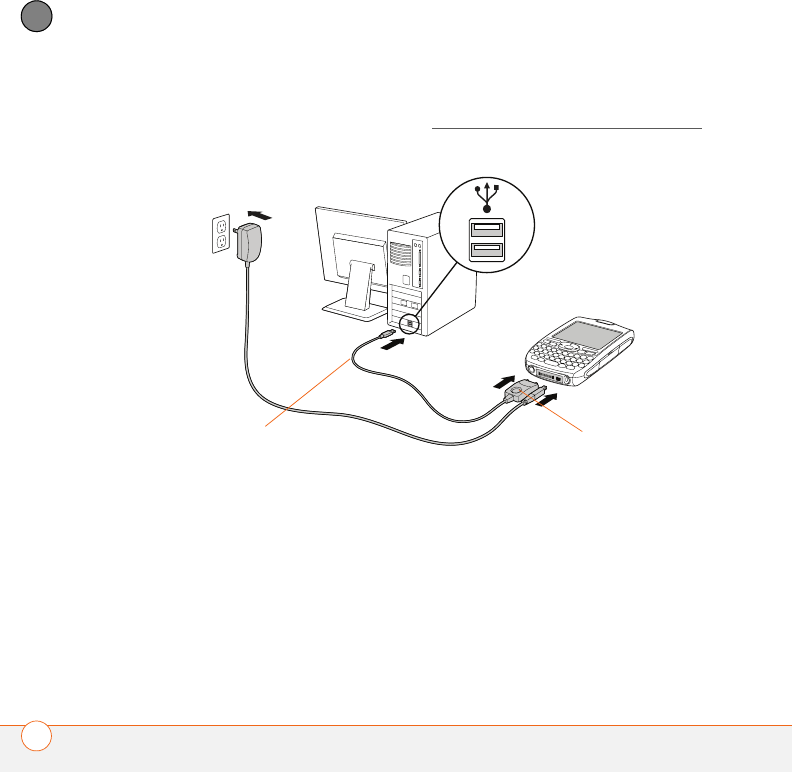
SETTING UP
22
1
CHAPTER
4Connect the charger cable to the
bottom of your Treo 680.
You are now ready to synchronize; go to
Synchronizing information—the basics.
Sync cable Sync button
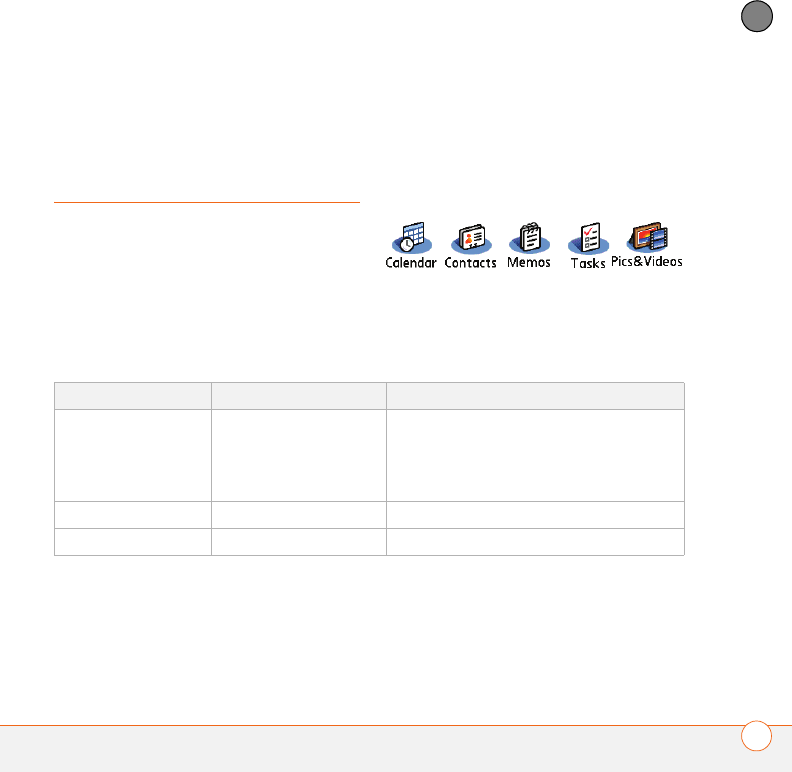
SETTING UP
23
1
CHAPTER
Synchronizing
information—the
basics
Synchronizing means that info you enter or
change in one place (your Treo 680 or your
computer) is automatically entered or
changed in the other; so there’s no need to
enter the info twice. We strongly
recommend that you sync your Treo 680
with your computer or corporate server
frequently to keep your info up-to-date (and
backed up) in both locations.
The info from all the following applications
is updated by default each time you sync
your Treo 680 with your desktop software:
How each application syncs depends on
your computer type and the desktop
software you are using, as follows:
0
Computer type Desktop software What syncs and where
Windows Microsoft Outlook •Calendar, Contacts, Memos, and
Tasks sync with Outlook
•Pictures & Videos syncs with
Palm Desktop
Windows Palm Desktop All apps sync with Palm Desktop
Mac Palm Desktop All apps sync with Palm Desktop
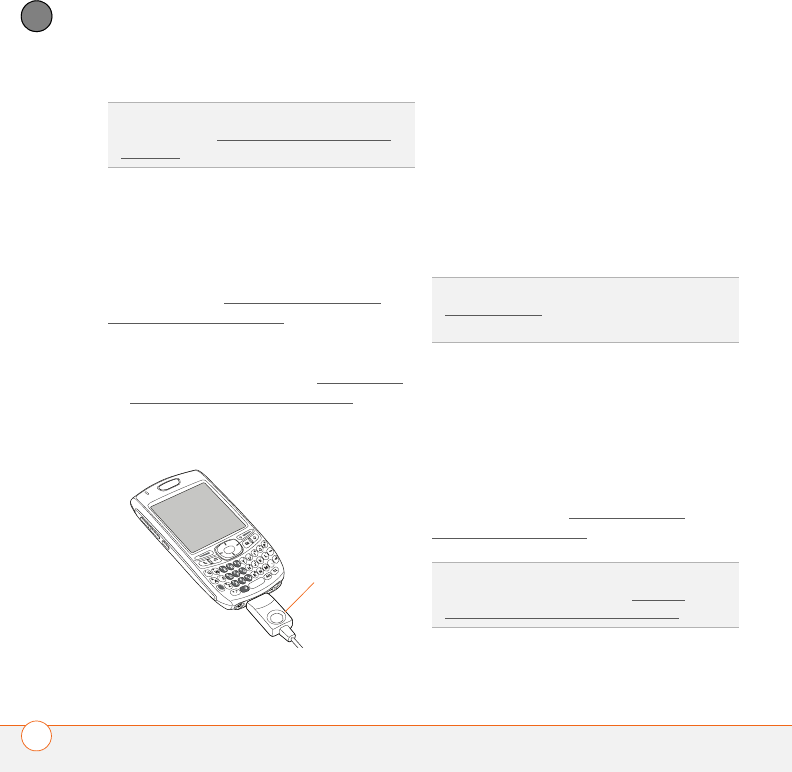
SETTING UP
24
1
CHAPTER
BEFORE YOU BEGIN To sync your info,
you must install Palm Desktop software
from the Palm Software Installation CD
that came with your Treo 680—even if you
sync with Outlook or another third-party
application. See Installing the desktop
synchronization software for instructions.
1Connect your Treo 680 to your
computer, as described in Connecting
your Treo 680 to your computer.
2Press the sync button on the sync
cable.
Messages on both your computer and
your Treo 680 indicate that
synchronization is in progress.
3Wait until you see the message on your
Treo 680 that the HotSync operation is
complete; then disconnect the sync
cable. Do not disconnect the sync cable
until you see this message.
If you’re finishing your initial setup, you
now have the option to install bonus
software from the Palm Software
Installation CD. If you choose to install
some of the bonus software, you need to
sync again to install the software on your
Treo 680. You can also install bonus
software later; see Installing bonus
software from the CD.
TIP
For more sync options, including which
apps sync, see Synchronizing information—
advanced.
Sync button
TIP
Problems synchronizing? See
Synchronization for troubleshooting
suggestions.
TIP
For info on locating your pictures and
videos on your computer, see Viewing
pictures and videos on your computer.

CHAPTER
2
Moving around on your
Palm
®
Treo
™
680 smart device
Have you ever been to a new city and felt a bit lost until you
figured out that the numbered streets run north/south and the
avenues run east/west? Learning to move around on your Treo
680 is similar. Most Palm OS® applications use the same set of
controls. So once you learn how to use these controls on your
Palm®Treo™ 680 smart device, you’ll be driving all over town
and you won’t even need a map.
Benefits
•Find and open applications quickly
•Access extra features with menus
•Move around in applications with
one hand, using the 5-way
navigator
•Access many more characters and
symbols than are displayed on the
keyboard

In this chapter
Moving around the screen . . . . . . . . . . . . . . . . . . . . . . . . . . . . . . . . 27
Using the keyboard . . . . . . . . . . . . . . . . . . . . . . . . . . . . . . . . . . . . . 31
Opening applications . . . . . . . . . . . . . . . . . . . . . . . . . . . . . . . . . . . . 35
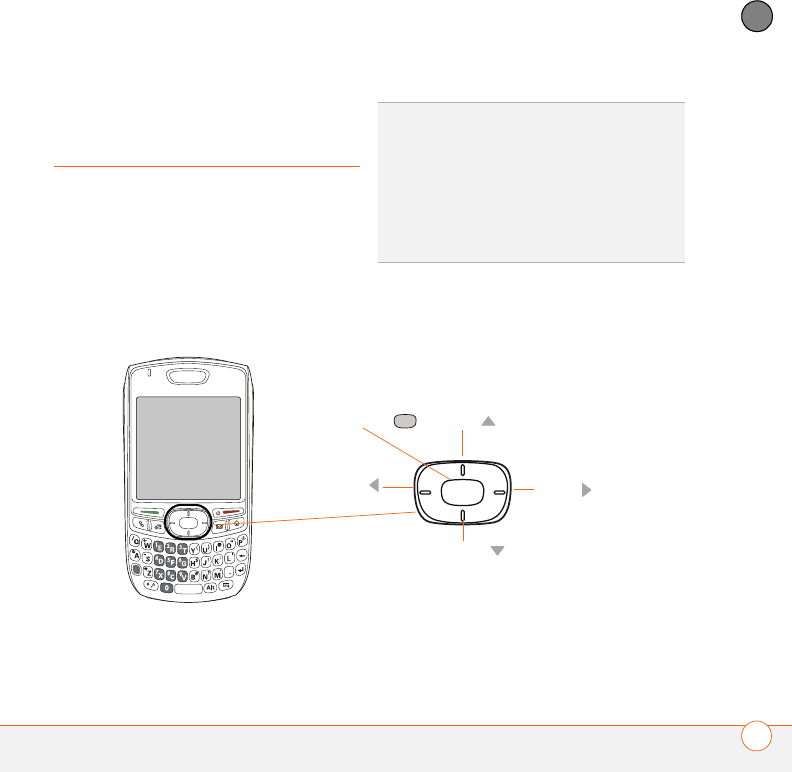
MOVING AROUND ON YOUR PALM®TREO™ 680 SMART DEVICE
27
2
CHAPTER
Moving around the
screen
To move around the Treo 680 screen, you
can use the 5-way navigator for
one-handed navigation, or you can tap
items on the screen with the stylus. With
use, you will find your own favorite way to
scroll, highlight, and select menu items. The 5-way includes the following buttons:
TIP
Some third-party applications may not
work with the 5-way navigator, and you must
use the stylus instead
DID
YOU
KNOW
?
In this guide, we use arrow
icons to indicate directions on the 5-way.
These are different from any onscreen arrows
that you tap with your stylus or select with the
5-way to display pick lists.
Up
Right
Left
Down
Center
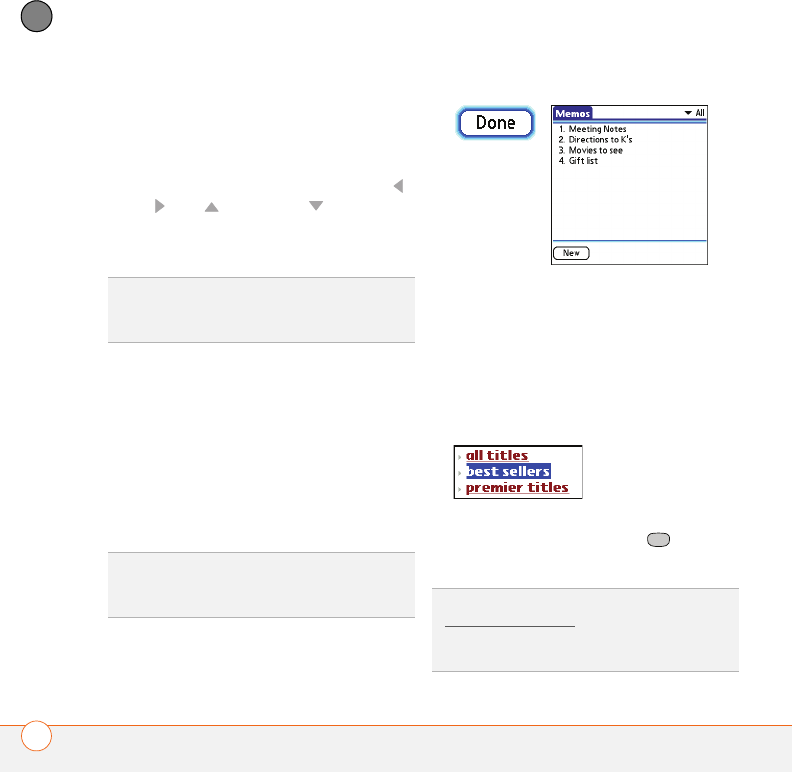
MOVING AROUND ON YOUR PALM®TREO™ 680 SMART DEVICE
28
2
CHAPTER
Highlighting and selecting items
On most screens, one item—a button, a
list entry, or a check box—is highlighted by
default. The highlight identifies which item
is affected by your next action. Use Left ,
Right , Up , and Down on the
5-way to move the highlight from one item
to another.
Learn to recognize the highlight. It can take
two forms:
Border glow: When an entire screen, an
onscreen button (such as Done, New, or
OK), or a pick list is highlighted, a glow
appears around its border. If an entire
screen is highlighted, the glow appears at
the top and bottom of the screen only.
Colored background: When a phone
number, text, an email address, a web link,
or an item in a list is highlighted, the item is
displayed as white text against a colored
background. Examples of lists include the
Contacts list, the Messaging Inbox, and the
Tasks list.
After highlighting an item, you can select or
activate it by pressing Center , or by
tapping the item with the stylus.
TIP
If the item you want doesn’t appear on the
screen, try tapping the onscreen scroll arrows
to view more info.
TIP
When a border appears at the top and
bottom of a list screen, press Center on the
5-way to highlight the first item in the list.
TIP
After you open an application (see
Opening applications), experiment with using
the 5-way to highlight various screen
elements.
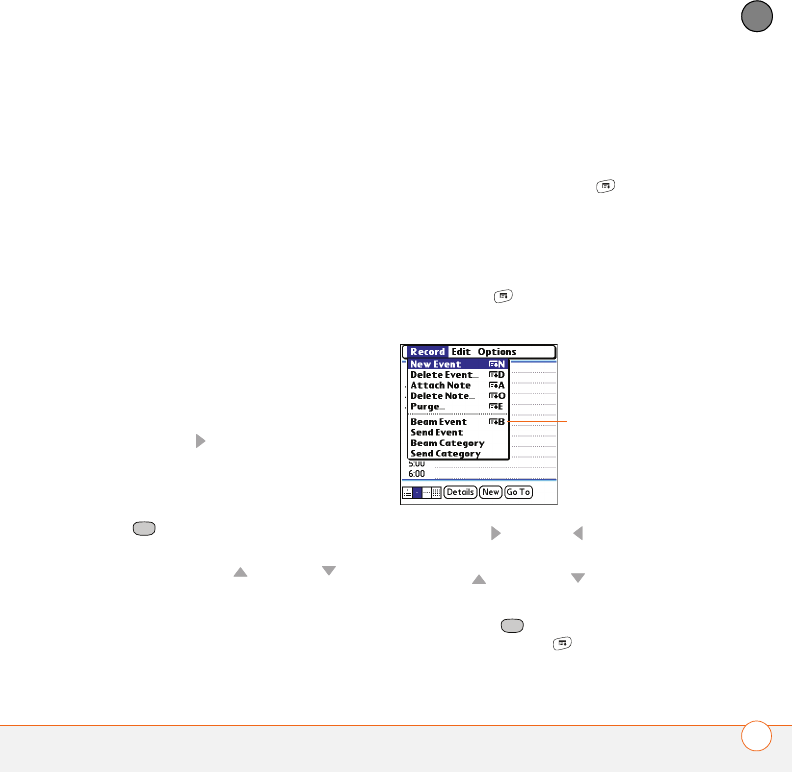
MOVING AROUND ON YOUR PALM®TREO™ 680 SMART DEVICE
29
2
CHAPTER
Highlighting text
You can use the stylus to highlight text on
the screen.
•Tap and drag the stylus across the text
you want to highlight.
•To highlight a word, double-tap it.
•To highlight a paragraph, triple-tap it.
Accessing command buttons
In most applications, command buttons
such as New, OK, and Details appear at the
bottom of the screen. In many cases, you
can jump directly to these buttons instead
of scrolling to them.
•From a list screen, such as the Memos
list, press Right to jump to the first
button.
•From a screen where you create or edit
entries, such as Contact Edit, press
Center to jump to the first button.
•From a dialog box, such as Edit
Categories, press Up or Down to
scroll to the buttons.
Selecting menu items
Many applications have menus to give you
access to additional features. These menus
are usually hidden from view, but they
appear when you press Menu . To get
the most out of your Treo 680, it’s a good
idea to familiarize yourself with the
additional features available through the
various application menus.
1Press Menu to display an
application’s menus.
2Press Right and Left to switch
between menus.
3Press Up and Down to highlight a
menu item.
4Press Center to select the menu
item, or press Menu to close the
menu and cancel your selection.
Menu shortcut
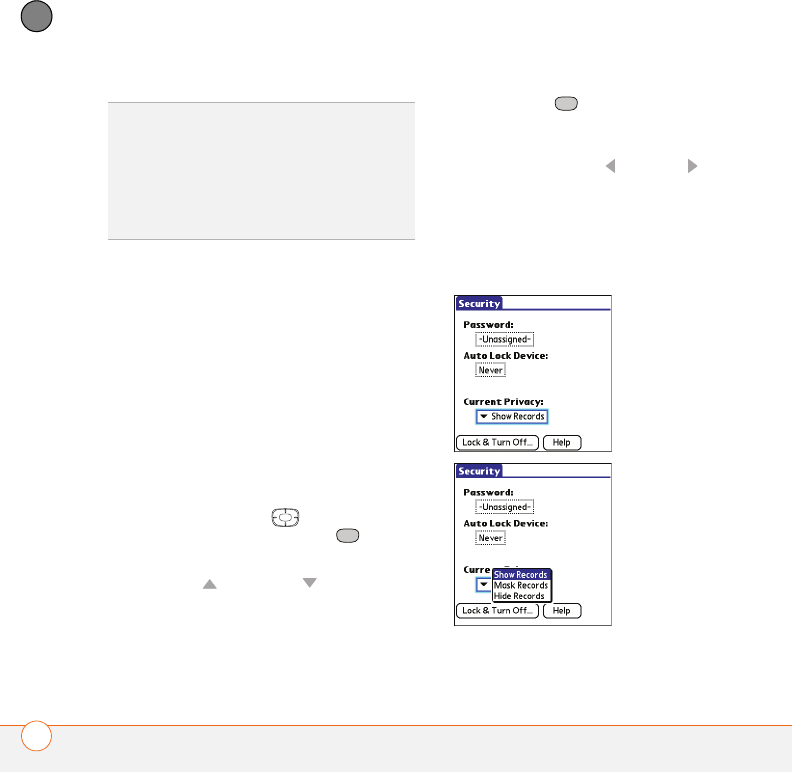
MOVING AROUND ON YOUR PALM®TREO™ 680 SMART DEVICE
30
2
CHAPTER
Selecting options in a pick list
A range of options is often presented in a
type of menu called a pick list, which can
be identified by a downward-pointing
arrow. Pick lists are different from the
application menus previously described.
The application menus give you access to
additional features and pick lists let you
select the contents for a particular field.
You can select items from a pick list with
the 5-way or the stylus.
5-way: Use the 5-way to highlight the
pick list, and then press Center to
display the items in the list.
•Press Up and Down to highlight
the item you want.
•Press Center to select the
highlighted item.
•To exit the pick list without making a
selection, press Left or Right .
Stylus: Use your stylus to tap the pick list.
•Tap the item you want from the list.
•To exit the pick list without making a
selection, tap outside the list.
TIP
Most menu items have menu shortcuts
listed in the menu. To use a menu shortcut,
press Menu plus the shortcut letter. You don’t
have to see the menu item to use the menu
shortcut. For example, when you’re in
Calendar, you can press Menu + N to create a
new event.
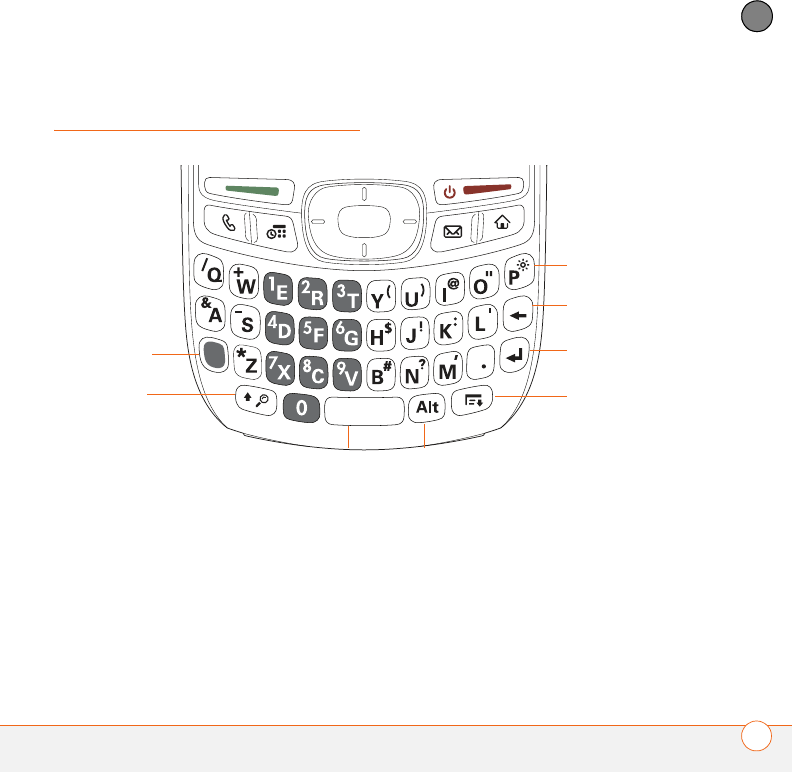
MOVING AROUND ON YOUR PALM®TREO™ 680 SMART DEVICE
31
2
CHAPTER
Using the keyboard
Menu
Backspace
Return
AltSpace
Option
Shift/Find
Backlight
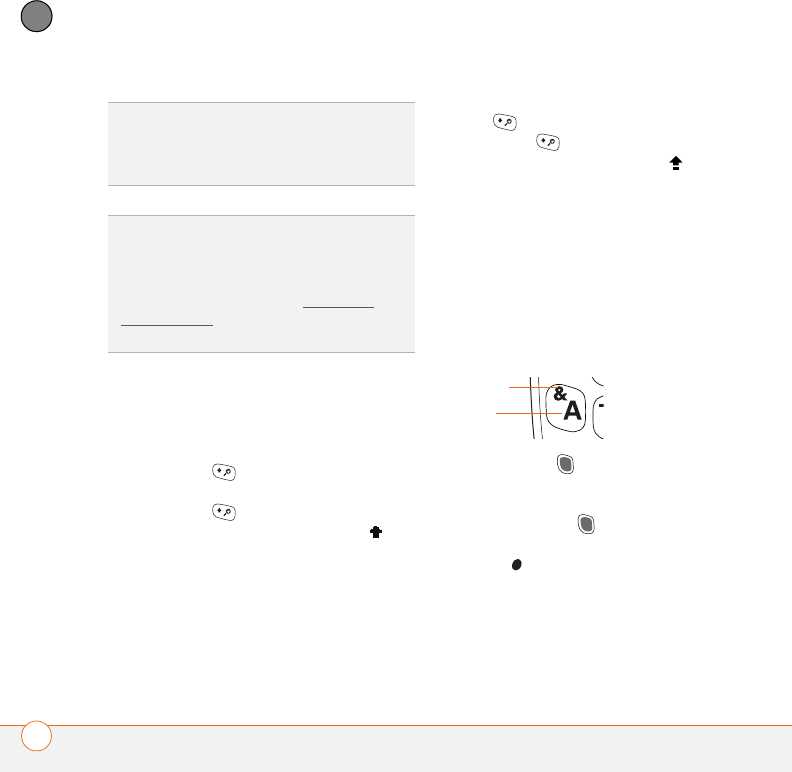
MOVING AROUND ON YOUR PALM®TREO™ 680 SMART DEVICE
32
2
CHAPTER
Entering lowercase and uppercase letters
•To enter lowercase letters, press the
desired keys.
•To enter an uppercase letter, press
Shift/Find and then press a letter
key. You don’t need to press and hold
Shift/Find while entering a letter.
When Shift is active, an up arrow
appears in the lower-right corner of the
screen.
•To turn Caps Lock on, press Shift/
Find twice. To turn it off, press
Shift/Find once. When Caps Lock
is on, an underlined up arrow
appears in the lower-right corner of the
screen.
Entering numbers, punctuation, and
symbols
Numbers, punctuation, and symbols
appear above the letters on the keys.
To enter these characters, do one of
the following:
•Press Option , and then press the
key with the desired character shown
above the letter. You don’t need to press
and hold Option while pressing the
second key. When Option is active, the
symbol appears in the lower-right
corner of the screen.
TIP
When using the keyboard, most people
find it easiest to hold the Treo with two hands
and use the tips of both thumbs to press the
keys.
DID
YOU
KNOW
?
The Treo 680 includes a
keyboard backlight that turns on and off when
the screen turns on or off. The backlight also
dims when an active call lasts longer than a
specified period of time. See Optimizing
power settings to adjust the automatic
shut-off and dimming intervals.
Letter
Symbol
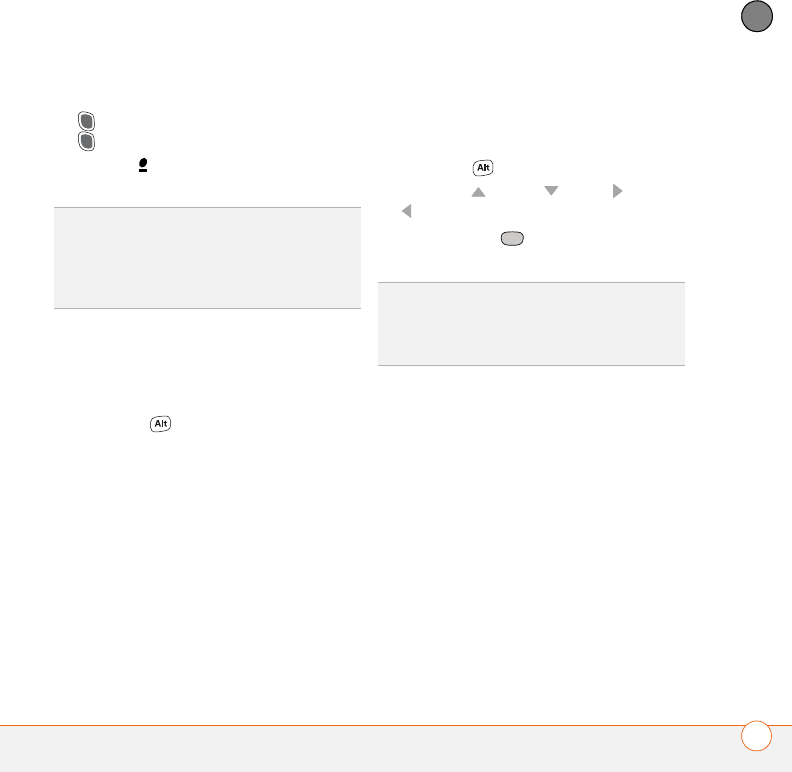
MOVING AROUND ON YOUR PALM®TREO™ 680 SMART DEVICE
33
2
CHAPTER
•To turn Option Lock on, press Option
twice. To turn it off, press Option
once. When Option Lock is on, the
symbol appears in the lower-right
corner of the screen.
Entering other symbols and accented
characters
Symbols and accented characters that do
not appear on the keyboard are available by
using the Alt key.
1Enter the character that corresponds to
the symbol or accented character you
want. See the table on the next page.
2Press Alt .
3Press Up , Down , Right , or Left
to highlight the desired character.
4Press Center to insert the
character.
DID
YOU
KNOW
?
Some application views
automatically default to Option Lock, such as
the Dial Pad tab in the Phone application or
the Calculator. In this case, you do not need to
press Option to enter numbers.
DID
YOU
KNOW
?
Alternate characters are
grouped by their similarity to the base key. For
example, the alternate characters for the e key
are é, è, ë, and ê.
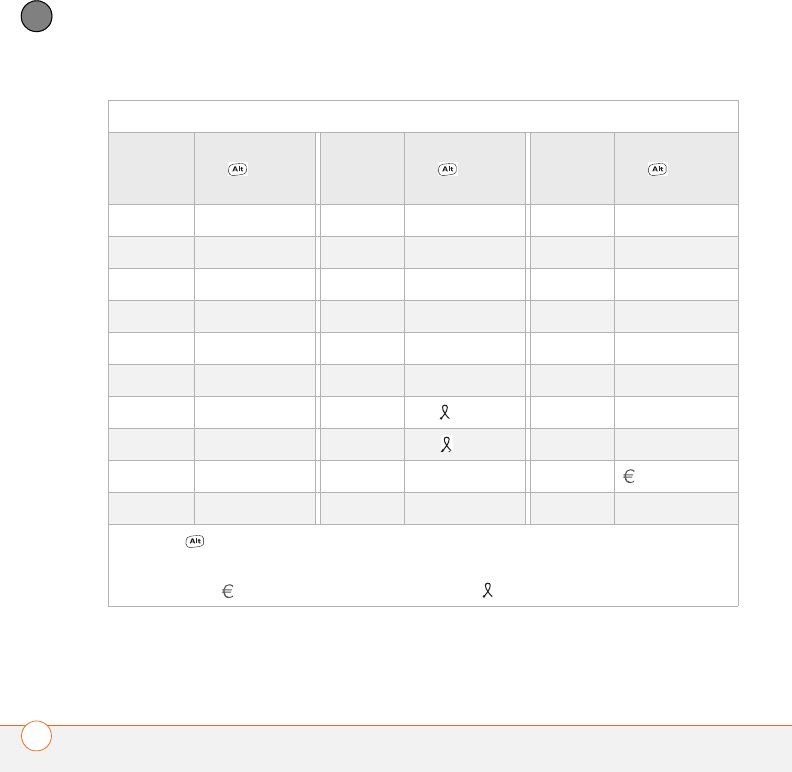
MOVING AROUND ON YOUR PALM®TREO™ 680 SMART DEVICE
34
2
CHAPTER
0
Symbols and accented characters
Enter… Then press
Alt to
select…
Enter… Then press
Alt to
select…
Enter… Then press
Alt to
select…
a á à ä â ã å æ n ñ u ú ù ü û
AÁ À Ä Â Ã Å Æ NÑ UÚ Ù Ü Û
b or B ß o ó ò ö ô œ õ x or X x ¤
cç ¢ © OÓ Ò Ö Ô Œ Õ y ý ÿ
C Ç ¢ © p or P ¶ Y Ý Ÿ
eé è ë ê r or R ® ! ¡
E É È Ë Ê s ß š ? ¿
ií ì ï î Sß Š ::-) :-( ;-)
I Í Ì Ï Î t or T ™ $ £ ¥ ¢
l or L £
Press Alt by itself, after a space or at the beginning or end of a line, to select these
characters:
; _ • \ % = ° ÷ £ ¥ ¢ [ ] { } < > « » © ® ™ ~ ^ ø |
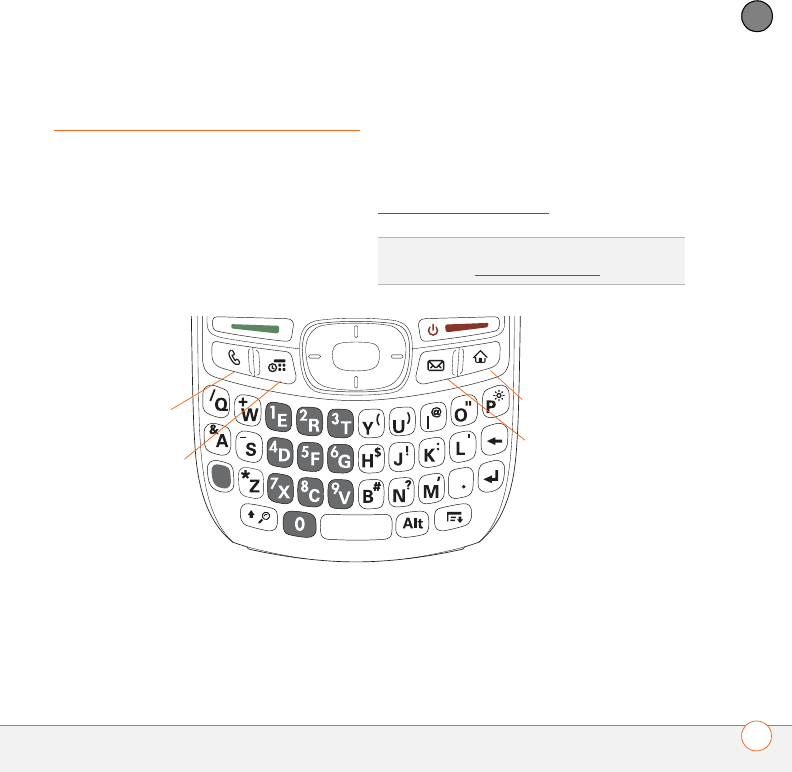
MOVING AROUND ON YOUR PALM®TREO™ 680 SMART DEVICE
35
2
CHAPTER
Opening applications
When you open an application using a
quick button or Applications View, you
automatically close the app you were
previously using.
Using the quick buttons
The front of the Treo 680 has three quick
buttons—Phone, Calendar, and
Messaging—that open applications. The
fourth button opens Applications View (see
Using Applications View).
TIP
You can customize the quick buttons
yourself; see Reassigning buttons for details.
Phone
Calendar Messaging
Applications
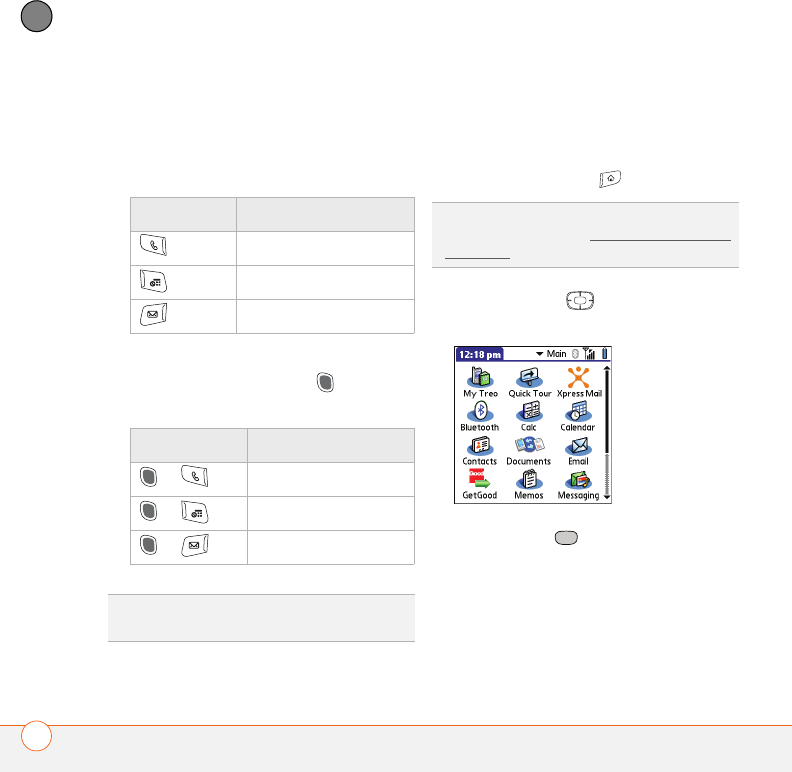
MOVING AROUND ON YOUR PALM®TREO™ 680 SMART DEVICE
36
2
CHAPTER
Each of quick button opens two
applications:
•To access a button’s primary application,
simply press the button.
•To access a button’s secondary
application, press Option and then
press the quick button.
Using Applications View
You can access all available applications
through Applications View.
1Press Applications .
2Use the 5-way to highlight the
application you want to use.
3Press Center to open the selected
application.
Button Primary app
Phone
Calendar
Xpress Mail
Buttons Secondary app
+ Web
+ Memos
+ Messaging
DID
YOU
KNOW
?
Pressing Option + Menu dims
your Treo 680 screen.
TIP
If prompted, press Center on the 5-way to
turn off Keyguard (see Locking your keyboard
(Keyguard) for more info).

MOVING AROUND ON YOUR PALM®TREO™ 680 SMART DEVICE
37
2
CHAPTER
In Applications View, you can also do any of
the following:
•Press Applications repeatedly to
cycle through various categories of
applications. See Applications settings
for more info on categories.
•Enter the first few letters of the
application’s name to highlight it. For
example, if you press P, it highlights
Phone; if you then press R, it highlights
Prefs. If you pause and then press R, it
highlights the first application that starts
with R.

MOVING AROUND ON YOUR PALM®TREO™ 680 SMART DEVICE
38
2
CHAPTER

CHAPTER
3
Your phone
The Phone application is your home base for making and receiving calls
and for storing info about the people you need to stay in touch with.
You can creatively manage multiple calls, such as swapping between
calls, sending text messages to ignored calls, and creating conference
calls with up to five callers. Your Palm
®
Treo
™
680 smart device helps
you perform all these tasks with ease.
And you can do more than manage your phone calls, too. You can send
text messages, open applications, go to your favorite web pages, see
your upcoming appointments, and even find out how many unread
email messages you have.
Benefits
•Stay in touch—you choose how
•Save time with shortcuts to your
favorite info
•Have fun: add wallpaper and
ringtones

In this chapter
Turning your Treo 680 on and off . . . . . . . . . . . . . . . . . . . . . . . . . . . 41
Making calls . . . . . . . . . . . . . . . . . . . . . . . . . . . . . . . . . . . . . . . . . . . 43
Receiving calls . . . . . . . . . . . . . . . . . . . . . . . . . . . . . . . . . . . . . . . . . 47
Using voicemail . . . . . . . . . . . . . . . . . . . . . . . . . . . . . . . . . . . . . . . . 48
What can I do when I’m on a call?. . . . . . . . . . . . . . . . . . . . . . . . . . 50
How many minutes have I used?. . . . . . . . . . . . . . . . . . . . . . . . . . . 56
Entering names and phone numbers. . . . . . . . . . . . . . . . . . . . . . . . 57
Defining favorite buttons . . . . . . . . . . . . . . . . . . . . . . . . . . . . . . . . . 61
Using a hands-free device . . . . . . . . . . . . . . . . . . . . . . . . . . . . . . . . 64
Customizing phone settings. . . . . . . . . . . . . . . . . . . . . . . . . . . . . . . 69
What are all those icons?. . . . . . . . . . . . . . . . . . . . . . . . . . . . . . . . . 75
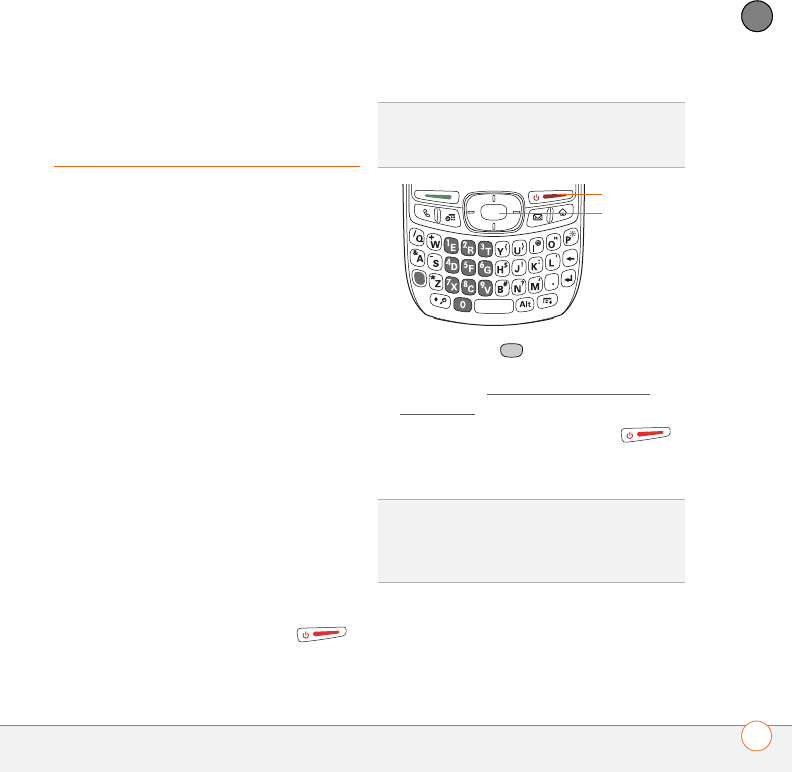
YOUR PHONE
41
3
CHAPTER
Turning your Treo 680
on and off
NOTE We use the term phone to describe
the feature of your Treo that lets you
connect to the Cingular Wireless network
to make and receive calls and transmit
data.
The phone and the screen of your Treo 680
can be turned off and on separately. This
means that you can wake up the screen to
use just the organizer features of your Treo
680, without turning on the phone. Also,
when the screen is turned off, the phone
can be on and ready for you to receive and
make calls.
Waking up the screen and turning it off
Wake up the screen and leave the phone
turned off when you want to use only the
organizer features of your Treo 680; for
example, when you’re on a plane and want
to look at your calendar.
1Press and release Power/End
to wake up the screen.
2Press Center to turn off Keyguard.
For more info about turning Keyguard on
and off, see Locking your keyboard
(Keyguard).
3Press and release Power/End
to turn off the screen and lock the
keyboard.
Turning your phone on and off
When your phone is on, it is connected to
the Cingular Wireless network (provided
TIP
You can also press any of the quick buttons
or the Applications button to wake up your
Treo 680 screen.
TIP
You can set how long the screen stays on.
Press Applications, select Preferences,
select Power, and then adjust the Auto-off
after setting.
Center
Power/End
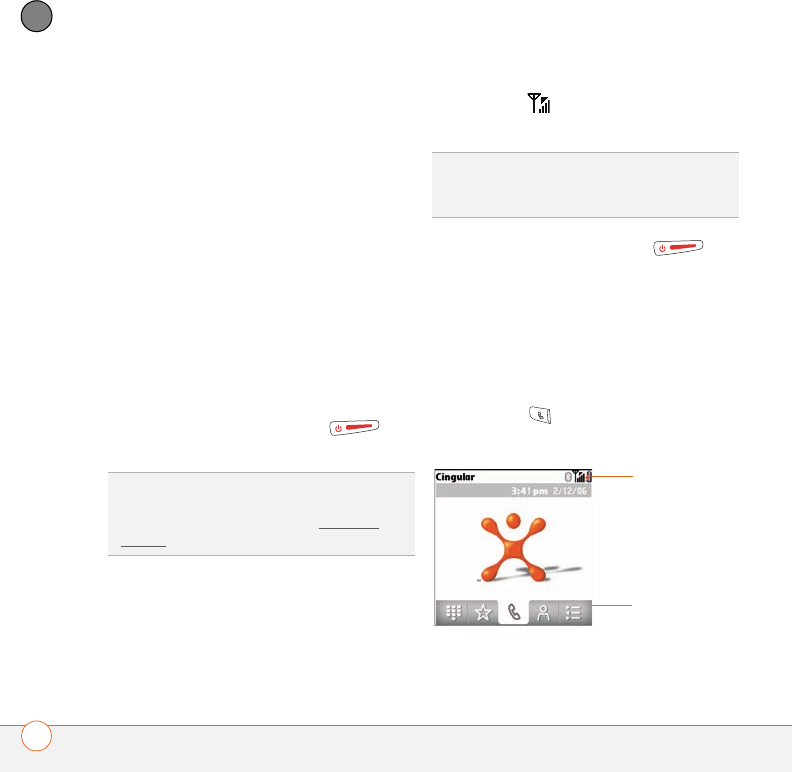
YOUR PHONE
42
3
CHAPTER
you are in a coverage area) so that you can
make and receive phone calls and use
wireless services, such as email,
messaging, and the web browser. During
initial setup, your phone is automatically
turned on, so you can use wireless
services right away.
If you turn off your phone, you can still use
the organizer features such as Calendar
and Contacts, as well as the media
features such as Pocket Tunes and Pictures
& Videos. You might hear this referred to as
flight mode because you must turn your
phone off when you’re on a plane.
1Wake up the screen.
2Press and hold Power/End to
turn on your phone.
You know your phone is on and that
you’re inside a coverage area when you
go to the Main tab of the Phone
application and you see the Signal
Strength icon at the top of the
screen.
3Press and hold Power/End
again to turn off your phone.
You know your phone is off when you
go to the Main tab of the Phone
application and you see Phone Off at
the top of the screen.
Opening the Phone application
Press Phone to display the Main tab in
the Phone application.
TIP
If the Ringer switch is in the Sound On
position, you hear a series of tones when you
turn your phone on and off (see Silencing
sounds).
TIP
If you’re outside a coverage area, No
Service appears in the upper-left corner and
the indicator light flashes red.
Tabs
Status icons
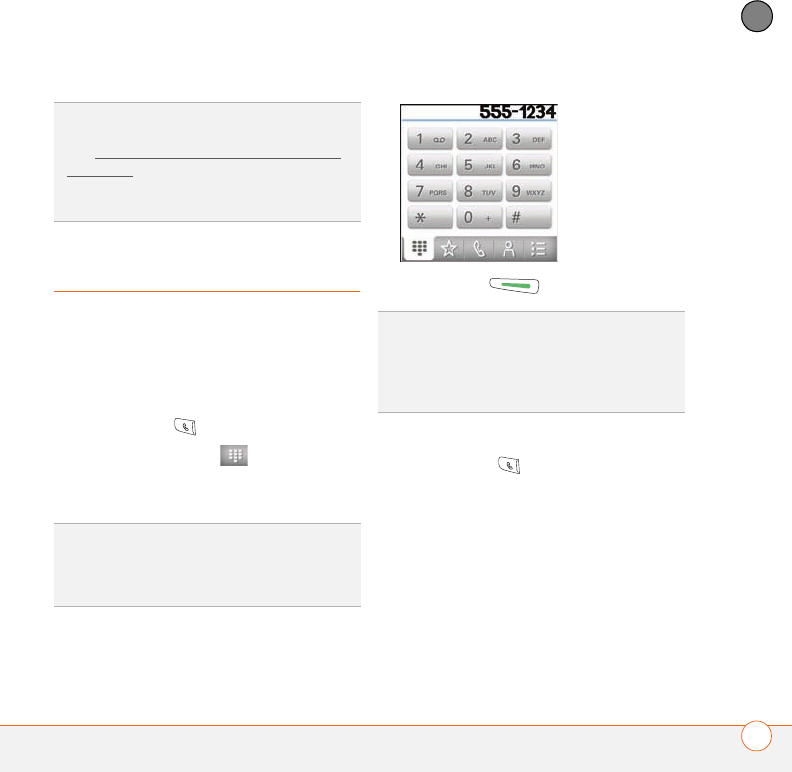
YOUR PHONE
43
3
CHAPTER
Making calls
There are several ways to make a call. Try
them all to find out which way you like
best.
Dialing using the onscreen Dial Pad
1Press Phone .
2Select the Dial Pad tab.
3Enter the phone number by tapping the
onscreen Dial Pad with the stylus.
4Press Send to make the call.
Dialing using the keyboard
1Press Phone .
2Press the numbered keys to enter the
phone number. (You don’t need to press
Option.)
DID
YOU
KNOW
?
You can choose which tab
appears when you press the Phone button.
See Customizing the Main tab in the Phone
application for details. If you change the
default tab, you need to modify the steps in
this chapter accordingly.
TIP
Press Backspace to delete numbers
you’ve entered. To cancel the call altogether,
press Phone to return to the Main tab in the
Phone application.
DID
YOU
KNOW
?
You can paste numbers
directly into the Dial Pad. Copy a number from
another application, press Phone and select
the Dial Pad tab. Open the Edit menu and
select Paste. Press Send to dial the number.
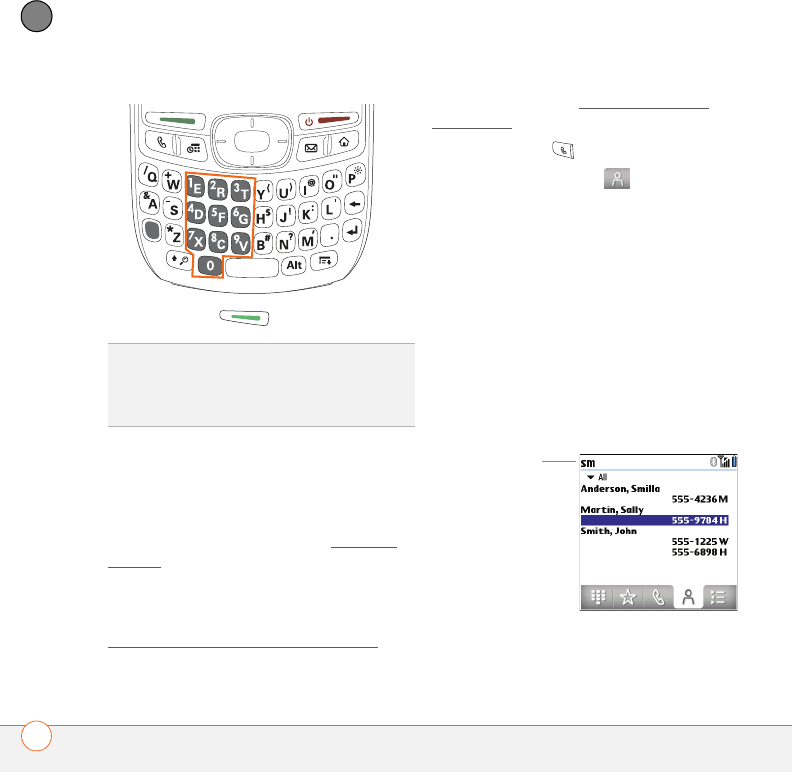
YOUR PHONE
44
3
CHAPTER
3Press Send to make the call.
Dialing by contact name
You need to have names and numbers in
your contact list before you can make a call
by contact name. You can add contacts
directly into your Treo 680 (see Adding a
contact), but the fastest way to enter lots
of contacts is to enter them in your
desktop software and then synchronize to
transfer them to your Treo 680 (see
Synchronizing information—the basics).
You can also import contacts from your
SIM card (see tip on Viewing your SIM
Phonebook).
1Press Phone .
2Select the Contacts tab.
3Using the keyboard, just start entering
one of the following for the contact you
want to call:
•First name (JOH for John)
•Last name (SMI for Smith)
•First initial and last name (JSM for
John Smith)
For example, entering SM would display
Smilla Anderson, John Smith, and
Sally Martin. Entering JSM finds only
John Smith.
TIP
After you enter a phone number, you can
also press Center on the 5-way to select
whether you want to make a phone call or
send a text message to that number.
Text appears
here as you
enter it
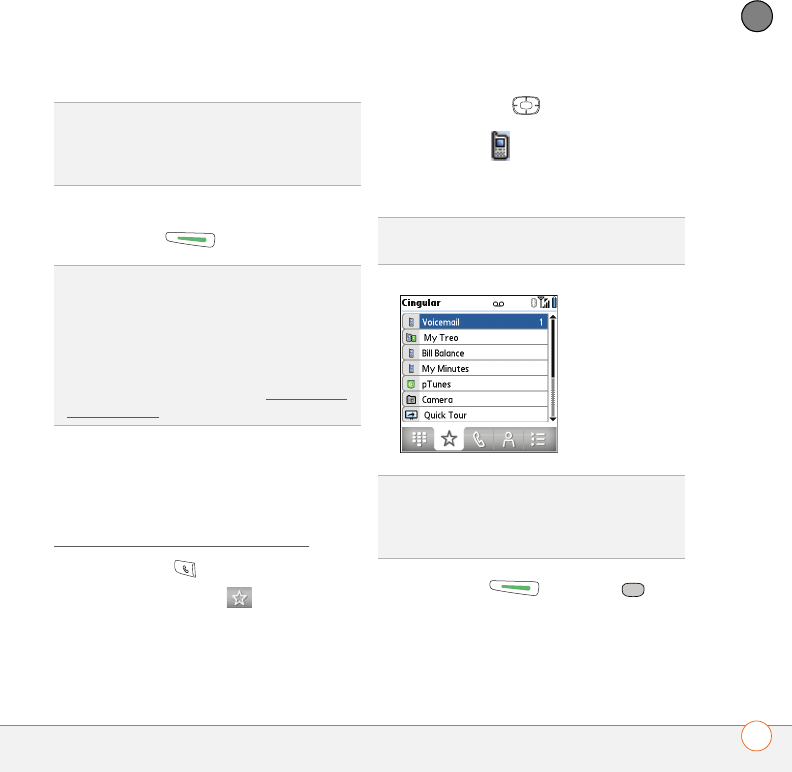
YOUR PHONE
45
3
CHAPTER
4Select the number you want to dial.
5Press Send to make the call.
Dialing with a speed-dial favorite button
Your Treo 680 comes with a few predefined
speed-dial favorite buttons, but you can
also create your own favorites. See
Creating a speed-dial favorite button.
1Press Phone .
2Select the Favorites tab.
3Use the 5-way to highlight the
speed-dial favorite you want.
Look for the icon to distinguish a
speed-dial favorite from other types of
favorites.
4Press Send or Center to
make the call.
TIP
To restart your search, press Backspace to
delete letters you’ve entered. Or press Phone
to return to the Main tab in the Phone
application.
TIP
To see more info for a contact, highlight
the name and press Center on the 5-way to
view the address, company, and other details.
DID
YOU
KNOW
?
If you want to be able to
search for a contact by entering a name from
the Main tab in the Phone application, you can
change a setting to do that (see Customizing
phone settings).
TIP
To view more favorite buttons, repeatedly
press Down on the 5-way.
TIP
You can see all the contact numbers for
the selected person or business. Highlight a
speed-dial favorite button and press Space
on the keyboard.
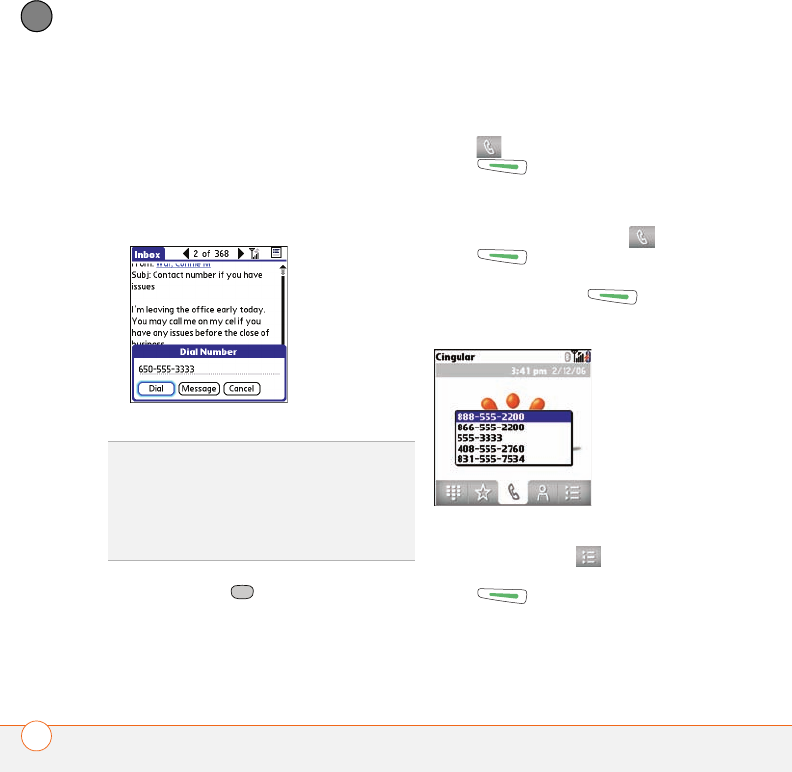
YOUR PHONE
46
3
CHAPTER
Dialing from a web page or message
Your Treo recognizes most phone numbers
that appear on web pages or in text, email,
or multimedia messages.
1Select the phone number on the web
page or in the message.
2Press Center to open the Dial
Number dialog box.
3Select Dial to make the call.
Redialing a recently called number
To dial the last number: Select the
Main tab, and then press and hold
Send to dial the last number you
called.
To select from your most recently dialed
numbers: Select the Main tab, press
Send to open the Redial list,
highlight the number you want to call,
and then press Send again to
make the call.
To select from your call history list:
Select the Call Log tab, highlight the
number you want to call, and then press
Send to dial the number.
TIP
If you can’t use the 5-way or stylus to
highlight and dial a phone number on a web
page or in a message, it means that your Treo
doesn’t recognize the number as a phone
number. You can still use the menus to copy
and paste the number into the Dial Pad.
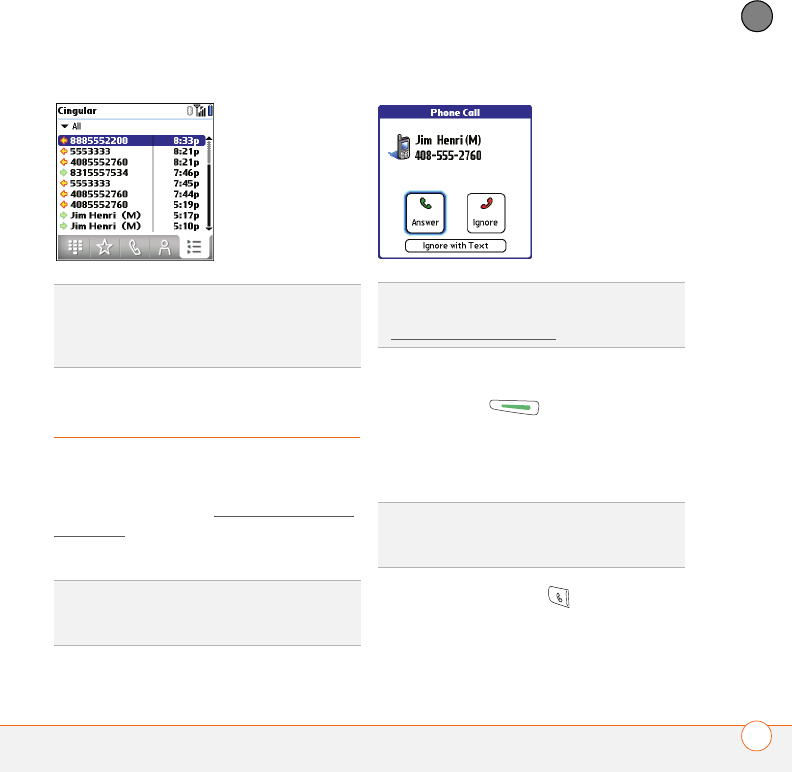
YOUR PHONE
47
3
CHAPTER
Receiving calls
To receive calls, your phone must be on.
This is different from having only the
screen turned on (see Turning your phone
on and off). When your phone is off, your
calls go to voicemail.
To answer a call, do one of the following:
•Press Send .
•Select Answer.
•Press the headset button (if the
headset is attached).
NOTE Pressing Phone silences the
ringer, but it does not answer the call.
DID
YOU
KNOW
?
You can send a text message
from Contacts or your Call Log by highlighting
a number, pressing Center on the 5-way, and
then selecting Message.
DID
YOU
KNOW
?
If music is playing and a call
arrives, the music pauses automatically and
resumes when you hang up or ignore the call.
TIP
See a photo of the person calling you!
Learn how to assign a caller ID photo in
Assigning a caller ID photo.
TIP
The headset button may work differently
on headsets other than the one provided with
your Treo 680.
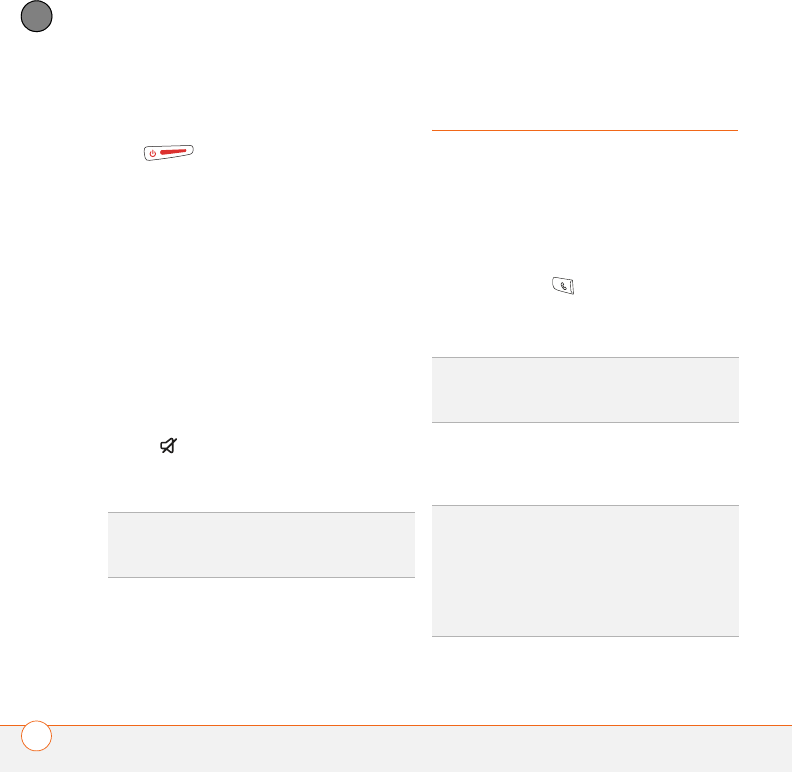
YOUR PHONE
48
3
CHAPTER
To ignore a call, do one of the following:
Send the call to voicemail: Press Power/
End or select Ignore.
Send the caller a text message: Select
Ignore with Text. This option sends the
call to voicemail and opens a text message
addressed to the caller.
NOTE Sending text messages to land line
phones may not be supported.
To silence the phone while it is ringing, do
one of the following:
•Press any key on your Treo except Send,
Power/End, or the 5-way.
•Slide the Ringer switch to the Sound
Off position. This immediately
silences all system sounds, including
the ringer.
Using voicemail
Your wireless service includes voicemail.
Keep in mind that airtime and other
charges apply when using voicemail from
your phone.
Setting up voicemail
1Press Phone .
2Press and hold 1 to dial the Cingular
Wireless automated voicemail system.
3Follow the voice prompts to set up your
voicemail.
DID
YOU
KNOW
?
When you silence the ringer
while it is ringing, you can either answer the
call or let it ring through to voicemail.
TIP
You can also access the Cingular Wireless
voicemail system by selecting the Favorites
tab and then selecting the Voicemail favorite.
TIP
If you can’t connect to the Cingular
Wireless’s voicemail system, contact Cingular
Wireless for assistance:
• Dial 611 from your Treo.
• Call 1-866-CINGULAR (1-866-246-4852)
from any phone.
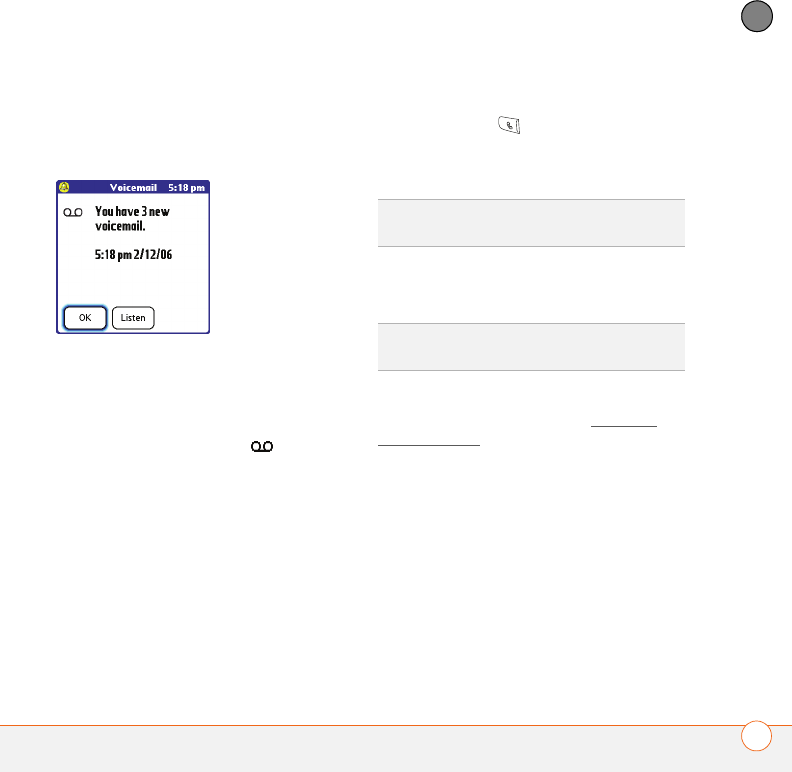
YOUR PHONE
49
3
CHAPTER
Voicemail notification
When you have a new voicemail message,
you are notified with an Alert dialog box.
•To dismiss the Alert dialog box, select
OK.
•To play the message, select Listen.
When you have messages that you have
not listened to, a Voicemail icon also
appears in the title bar of the Phone
application. You can also select this icon to
listen to your voicemail.
Listening to voicemail messages
1Press Phone .
2Press and hold 1 to dial the voicemail
system.
3Enter your voicemail password using
the keyboard.
NOTE If you defined Extra Digits for the
Voicemail favorite button (see Editing a
favorite button for details), you can select
this button to enter your password.
TIP
You can also select the Voicemail favorite
button to dial the voicemail system.
TIP
Remember, you don’t need to press
Option to enter numbers, *, or # during a call.
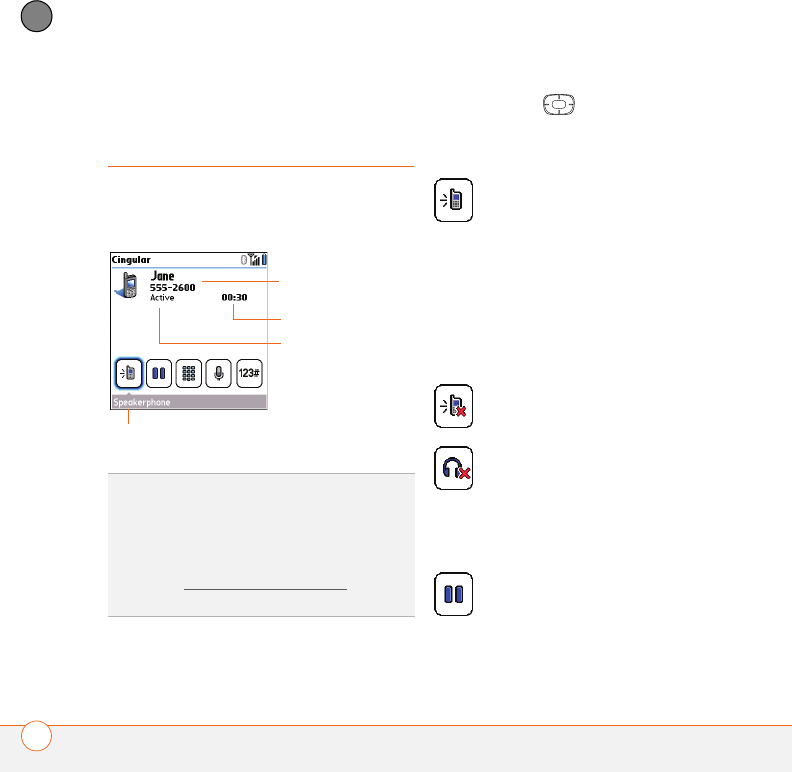
YOUR PHONE
50
3
CHAPTER
What can I do when
I’m on a call?
When you make or receive a call, Active
Call View appears.
Use the 5-way or stylus to select the
onscreen buttons. Here’s what the buttons
do:
0
TIP
If the screen dims during a call, press any
key except Send or Power/End to restore the
screen brightness.
DID
YOU
KNOW
?
You can set how long the
screen stays at full brightness during phone
calls. See Optimizing power settings for
details.
Caller’s name
and number
Call duration
Button label
Call status
Turns on the speakerphone, which
means that you and everybody
around you can hear the call. (Of
course, the caller can hear you as
well.) The advantage is that you
can check your calendar, look up
contact info, take notes, and use
other features during a call. This
button is not available when you
use a headset.
Turns off the speakerphone when it
is on.
Replaces the Speakerphone button
when you use a Bluetooth®
hands-free device. Select this
button to stop using the hands-free
device and switch to holding your
Treo 680 to your ear.
Puts a call on hold, and the call
status changes to On Hold. To take
the call off hold, select this button
again.
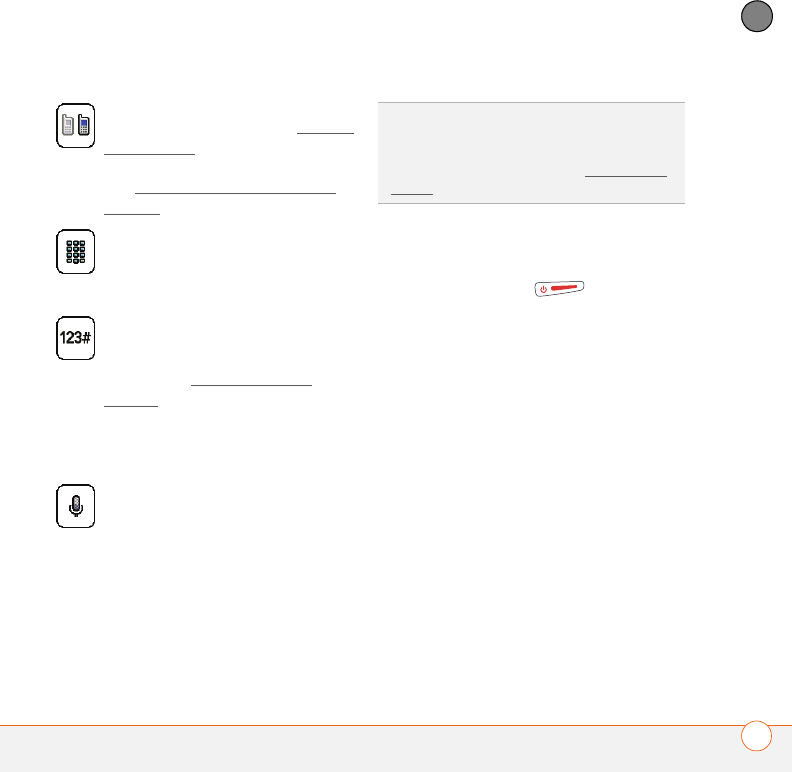
YOUR PHONE
51
3
CHAPTER
Ending a call
Do one of the following:
•Press Power/End .
•Press the button on the headset (if the
headset is attached).
Switching applications during a call
You can use your organizer apps and other
applications while you’re talking on the
phone; so go ahead and check your
calendar, or go to Memos and enter the
driving directions your caller is giving you.
You can even send text messages while
you’re on a call.
NOTE What you can’t do, however, is
make a data connection while on a call.
This means that you can’t browse the web
or send or receive email or multimedia
messages.
Lets you make another call while
the first call is on hold; see Making
a second call for details. For info on
handling a second incoming call,
see Receiving a second call (call
waiting).
Opens the Dial Pad so you can use
it to dial additional numbers, such
as an extension or a response to a
voice prompt.
Dials any extra digits (such as a
password or an extension) that you
assigned to a speed-dial favorite
button. See Defining favorite
buttons for information on defining
extra digits. This button disappears
after you select it to dial the
numbers.
Mutes the microphone so that you
and the noise around you can’t be
heard on the other end. The call
status changes to Muted. When
you want to speak, be sure to
select the Mute button again.
DID
YOU
KNOW
?
Do you accidentally press
onscreen buttons when you’re on a call? You
can disable the screen’s touch-sensitive
feature during phone calls, see Locking your
screen.
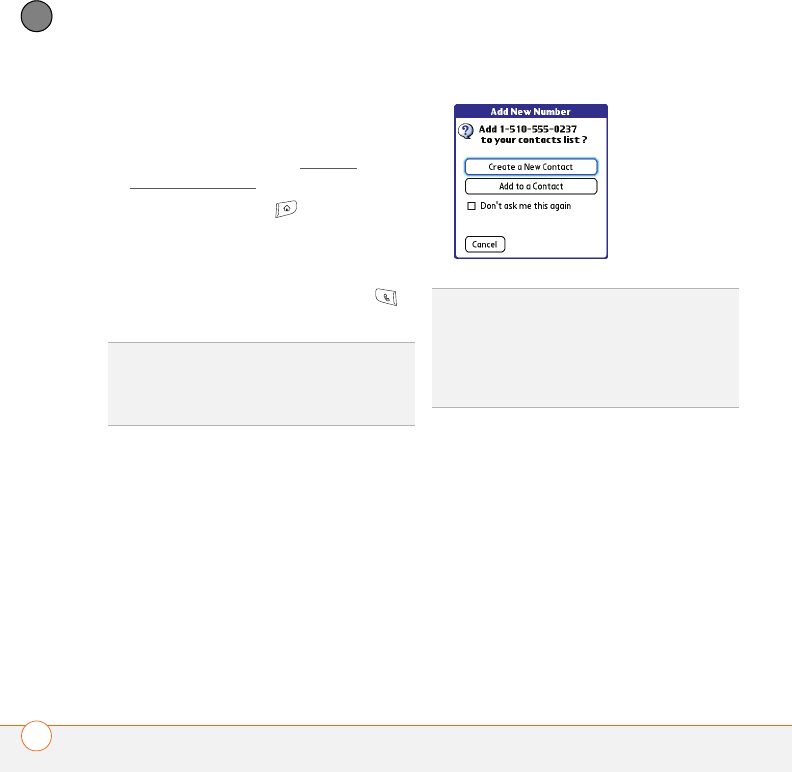
YOUR PHONE
52
3
CHAPTER
1(Optional) If you want to continue
talking while viewing another
application, select Speakerphone or
connect a headset (see Using a
hands-free device).
2Press Applications .
3Select the icon for the application you
want to open.
4When you’re ready to leave the app,
open another app or press Phone
to return to Active Call View.
Saving phone numbers
After you complete a call to a number that
is not in your Contacts list, you are
prompted to add the number to your
Contacts list.
•To create a new contact entry for this
number, select Create a New Contact,
and enter the contact’s info.
•To add this number to an existing
contact entry, select Add to a Contact,
and then select the contact. This pastes
the number into the first available phone
number field for that contact.
•To decline adding this number, select
Cancel.
DID
YOU
KNOW
?
You can press Phone to toggle
between Active Call View and the Main tab in
the Phone app, so you can access other tabs,
such as Contacts and Favorites, during a call.
TIP
You can turn the Add New Number prompt
on and off. In Contacts, open the Options
menu, and select Preferences. To turn this
option on, check the Ask to add unknown
phone numbers after calls box. To turn this
option off, uncheck this box.
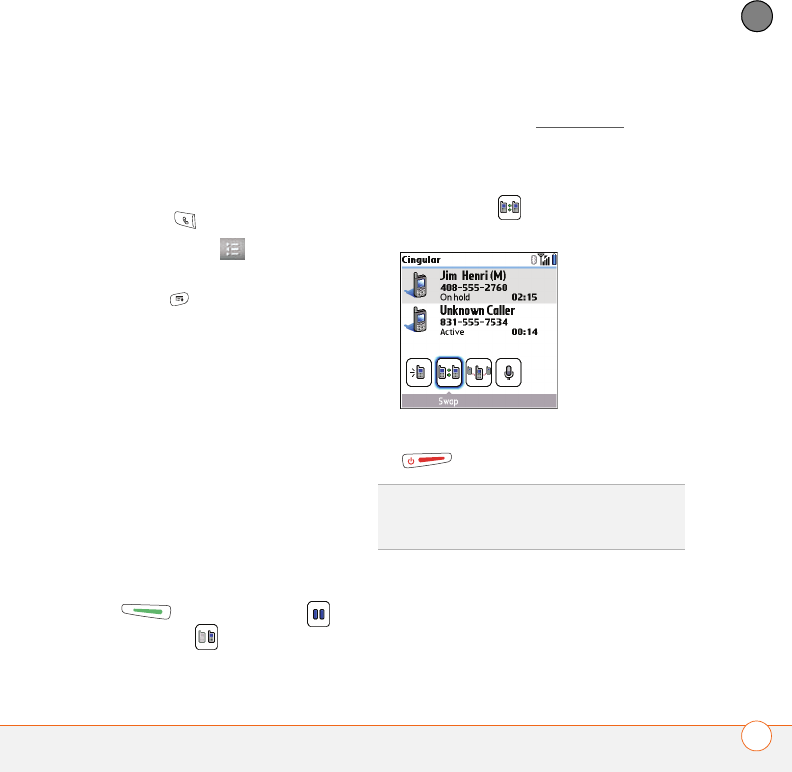
YOUR PHONE
53
3
CHAPTER
•To disable the Add New Number
prompt, check the Don’t ask me this
again box, and then select Cancel.
If you don’t add a number right away, follow
these steps to add it later.
1Press Phone .
2Select the Call Log tab.
3Highlight the number you want to save.
4Press Menu .
5Select Add Contact.
6Select New to create a new contact, or
select Add to add this number to an
existing contact.
7Enter the information for the entry, and
then select Done.
Making a second call
You can make a second call while your first
call is still active.
1Dial the first number and wait until the
person answers.
2Put the first call on hold by pressing
Send or selecting Hold .
3Select Add Call .
4Dial the second number.
NOTE To do this, you can use any of the
methods described in Making calls.
5When the Dial another call prompt
appears, select Ye s .
6Select Swap to switch between
the two calls.
7To end the active call, press Power/End
.
Receiving a second call (call waiting)
When you are on a call, you can receive a
second call and have separate
conversations with each caller. When the
second call comes in, you hear a call
DID
YOU
KNOW
?
When you hang up one call,
you can continue your conversation with the
remaining call.
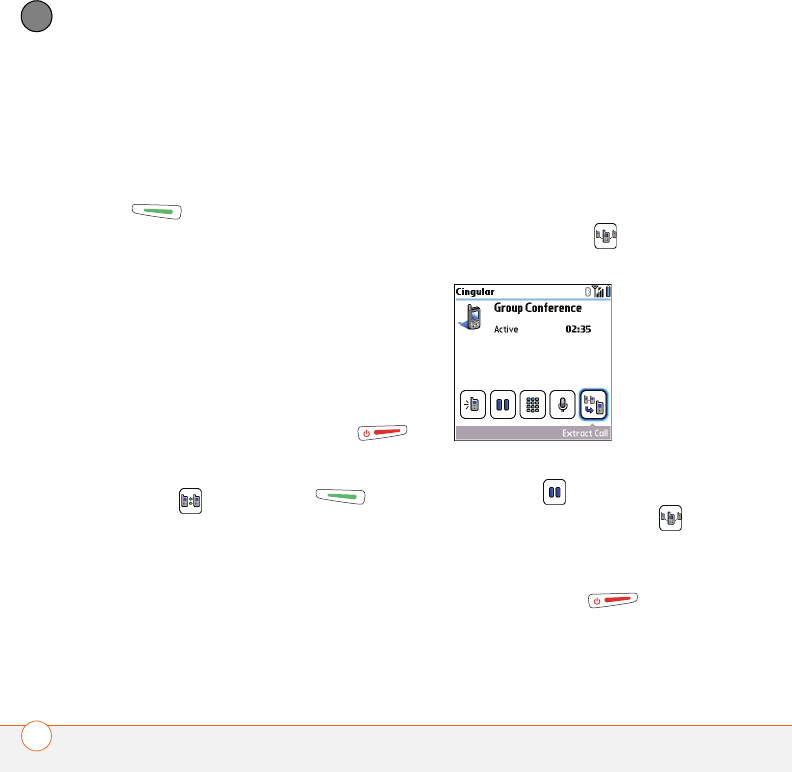
YOUR PHONE
54
3
CHAPTER
waiting tone and the Call Waiting dialog
box appears. You can do any of the
following to handle the second call:
•To place the current call on hold and
answer the new call, press Send
or select Answer.
•To send the new call to voicemail, select
Ignore.
•To send the new call to voicemail and
send the caller a text message, select
Ignore with Text.
NOTE Sending text messages to land line
phones may not be supported.
•To hang up the current call and answer
the new call, press Power/End .
•To switch between the original call and
the second call you answered, select
Swap or press Send .
Making a conference call
You can join a total of five other calls in a
conference call, provided that your network
and service plan include 6-way
conferencing. Please contact Cingular
Wireless for more information. Additional
charges may apply and minutes in your
mobile account may be deducted for each
call included in the conference call.
1While the first call is active, make a
second call.
2Select Conference . This joins you
and the two calls in a conference call.
3To add more calls to the conference,
select Hold , dial another number,
and then select Conference to add
the new call.
4To end the conference, make sure the
conference is the active call, and then
press Power/End .
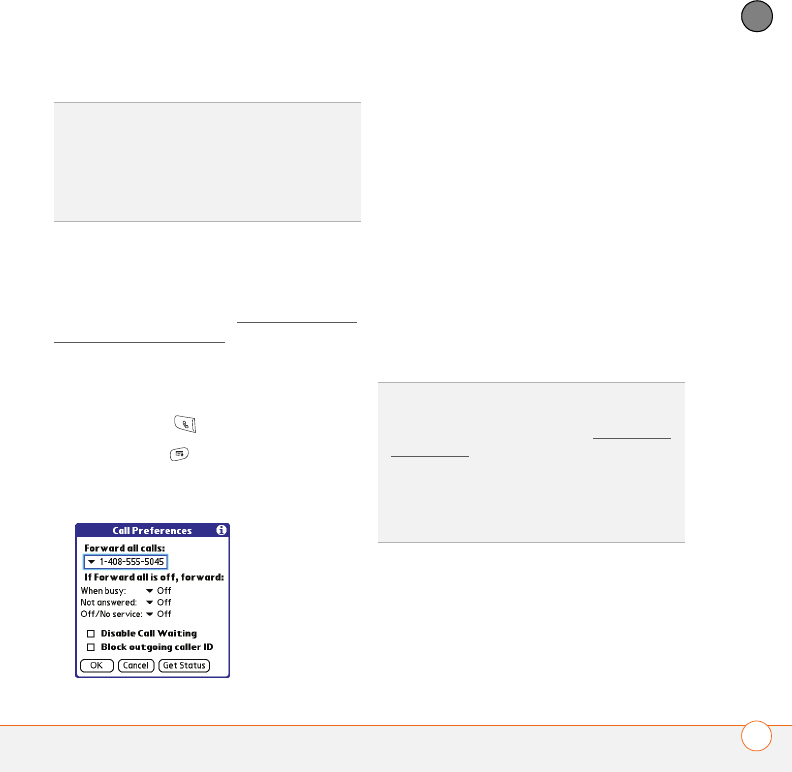
YOUR PHONE
55
3
CHAPTER
Forwarding all calls
You can forward all your calls to another
telephone number. You can also selectively
forward certain calls (see Forwarding calls
under certain conditions). Please check
with Cingular Wireless about availability
and pricing of forwarded calls, as additional
charges may apply.
1Press Phone .
2Press Menu .
3Select Options, and then select Call
Preferences.
4Select the Forward all calls pick list.
•If the forwarding number appears in
the pick list, select the number.
•If the forwarding number does not
appear in the pick list, select Edit
Numbers, and then select New.
Enter a forwarding number, including
the area code and country code if
they are different from your mobile
phone number. Select OK. Select the
number you just entered, and then
select OK.
5Select OK.
Forwarding calls under certain conditions
You can forward calls to another number
when the line is busy, a call is unanswered,
your Treo 680 is off, or you are outside a
coverage area.
TIP
If you want to continue a conversation
with one of the people on a conference call,
you can extract that call from the conference.
Select Extract Call (the onscreen button on
the far right), and then select the call you want
to extract.
TIP
After you set the number you want to
forward all your calls to, the call forwarding
icon appears in the title bar (see What are all
those icons?). We also recommend that you
call your Treo 680 to confirm that your call
forwarding settings work properly.
TIP
To turn off forwarding for all calls, select
Off from the Forward all calls pick list.
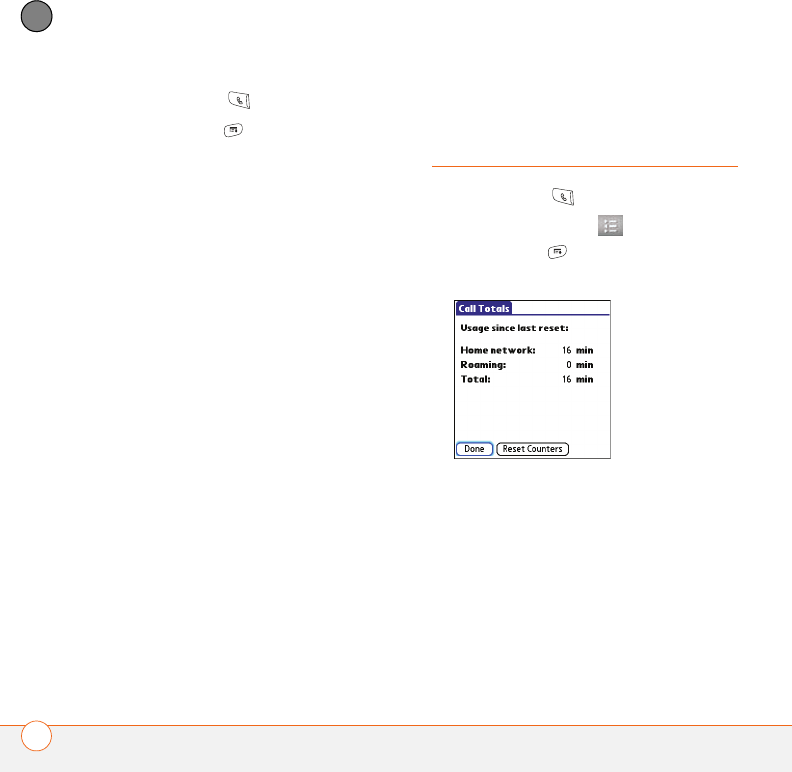
YOUR PHONE
56
3
CHAPTER
1Press Phone .
2Press Menu .
3Select Options, and then select Call
Preferences.
4Select the Forward all calls pick list and
select Off.
5Select any of the following pick lists:
When busy: Forwards calls if the phone
is busy.
Not answered: Forwards calls if you do
not answer.
Off/No service: Forwards calls when
your Treo 680 is not connected to a
mobile network.
6If the forwarding number appears in the
pick list, select the number. If the
forwarding number does not appear in
the pick list, select Edit Numbers and
then select New. Enter a forwarding
number, and select OK. Select the
number you just entered.
7Select OK, and then select OK again.
How many minutes
have I used?
1Press Phone .
2Select the Call Log tab.
3Press Menu .
4Select To t a l s from the Record menu.
5(Optional) To reset the counters to zero,
select Reset Counters.
6Select Done.
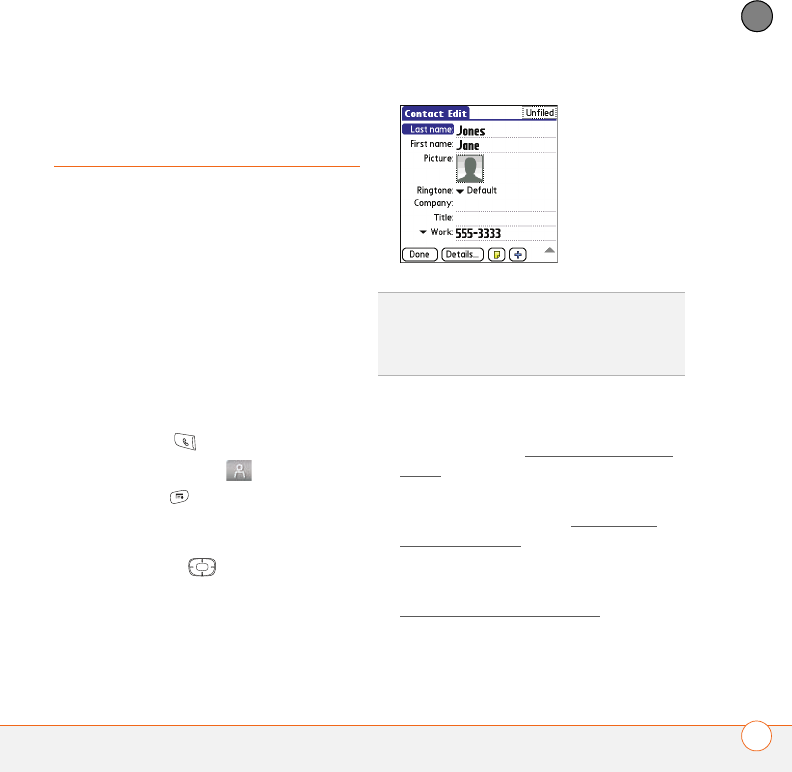
YOUR PHONE
57
3
CHAPTER
Entering names and
phone numbers
Contacts is where you enter information
about the people you want to stay in
contact with. You can get to this info from
the Phone application, to dial phone
numbers and create favorites, and from the
Messaging and email applications, to send
messages. When you create a contact, you
can also assign a photo and ringtone ID to
that contact, so you know when they call
you.
Adding a contact
1Press Phone .
2Select the Contacts tab.
3Press Menu .
4Select New Contact from the Record
menu.
5Use the 5-way to move between
fields as you enter info.
6Do any of the following:
Add a caller ID photo: Select the
Picture box. (See Assigning a caller ID
photo for more info.)
Add a caller ID ringtone: Select the
Ringtone pick list. (See Assigning a
caller ID ringtone for more info.)
Place the entry in a category and
mark it private: Select Details. (See
Working with private entries for more
info.)
DID
YOU
KNOW
?
If you add a symbol at the
beginning of a contact’s last name, such as
#Smith, the contact appears at the top of your
contact list.
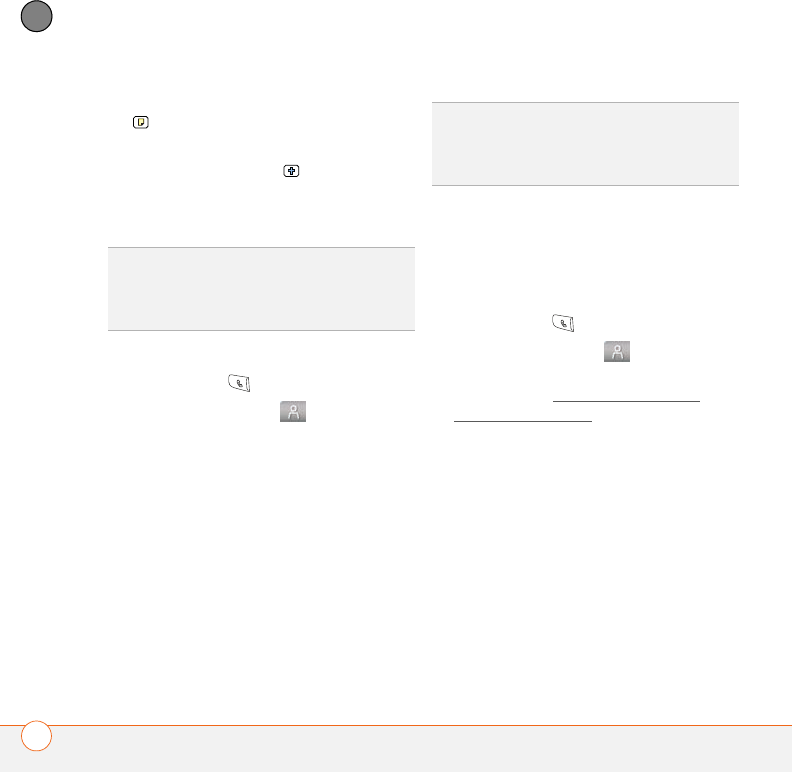
YOUR PHONE
58
3
CHAPTER
Add a note to an entry: Select Note
.
Display additional fields for this
contact: Select Plus .
7After you enter all the information,
select Done.
Viewing or changing contact information
1Press Phone .
2Select the Contacts tab.
3Begin entering one of the following for
the contact you want to view or edit:
•First name (JOH for John)
•Last name (SMI for Smith)
•First initial and last name (JSM for
John Smith)
4Select the name of the entry you want
to open.
5Select Edit.
6Make changes to the entry as
necessary, and then select Done.
Assigning a caller ID photo
1Press Phone .
2Select the Contacts tab.
3Open the contact you want to add the
photo to (see Viewing or changing
contact information).
4Select Edit.
5Select the Picture box and do one of
the following:
•Select Camera to take a photo and
add it to this contact entry when you
save the photo (if your Treo includes a
camera).
•Select Photos and select an existing
photo that you want to assign to this
contact.
TIP
Import contacts from your SIM card
quickly and easily. In the Contacts list, open
the Record menu and select Import from
SIM.
TIP
To edit the entries on your SIM card you
must either Import them into Contacts or
press Applications, select SIM Book, and
edit them in the phone book on your SIM card.
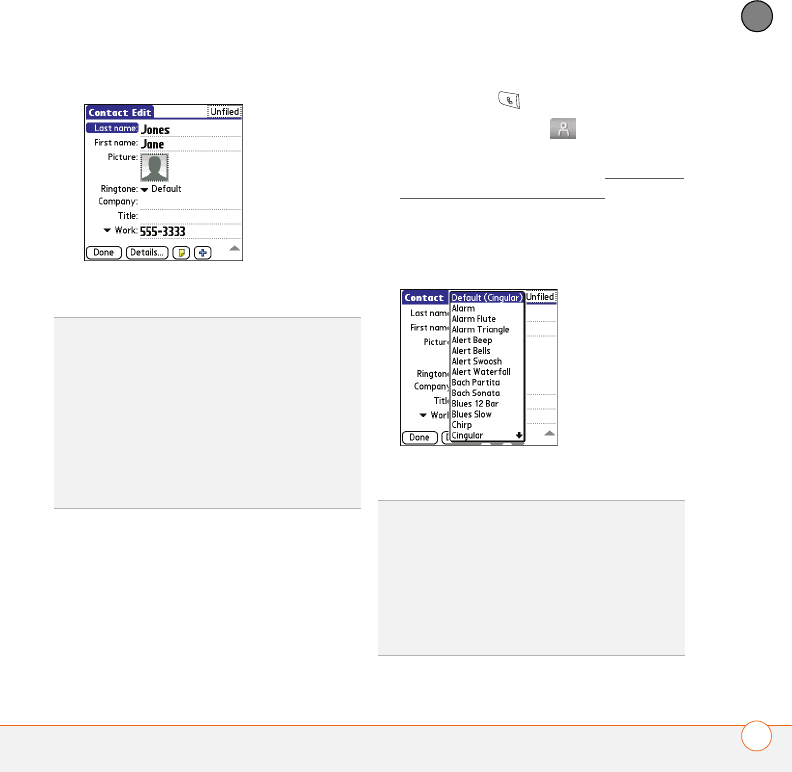
YOUR PHONE
59
3
CHAPTER
6Select Done.
Assigning a caller ID ringtone
Caller ID ringtones can let you know who is
calling before you even look at your Treo
680. This is a great way to identify calls
from important people in your life and to
screen calls that you’d prefer not to
answer.
1Press Phone .
2Select the Contacts tab.
3Open the contact to whom you want to
give a caller ID ringtone (see Viewing or
changing contact information).
4Select Edit.
5Select the Ringtone pick list and select
a tone for this contact entry.
6Select OK.
DID
YOU
KNOW
?
If you assign pictures to your
contacts in Microsoft Outlook or
Palm Desktop software and you install the
desktop software from the Palm Software
Installation CD, the pictures are automatically
added to your contact entries on your Treo
680 when you sync. If you use third-party
synchronization software, picture sync may
not be supported. Check with the software
developer for information.
TIP
You can assign a ringtone to an entire
category of contacts. For example, use a
special ringtone for categories such as Family,
Work, or Golf Buddies. Select the category
pick list in the upper-left corner and select Edit
Categories. Select the category, and then
select Edit. Select the ringtone on the Edit
Category screen.
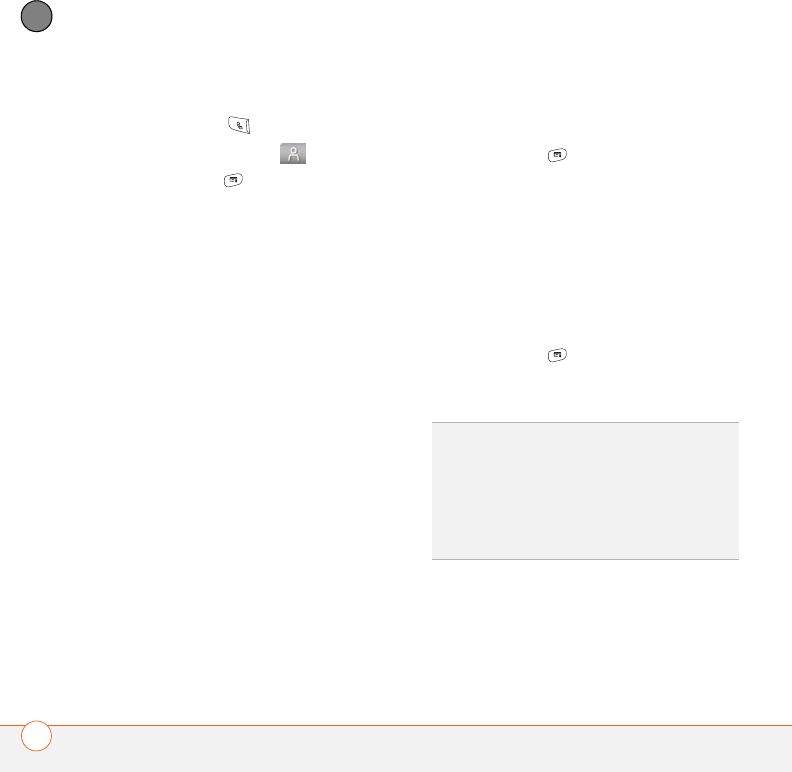
YOUR PHONE
60
3
CHAPTER
Customizing Contacts
1Press Phone .
2Select the Contacts tab.
3Press Menu .
4Select Options, and then select
Preferences.
5Set any of the following options:
Remember Last Category: Sets
whether Contacts opens to the last
category you selected.
Show SIM Phonebook: Sets whether
SIM Phonebook appears as an option in
the category pick list. When you check
this box, you can view entries in the
phone book on your SIM card.
Ask to add unknown phone numbers
after calls: Sets whether you are
prompted to add phone numbers that
are not in your Contacts list after a call.
You can add unknown numbers to an
existing contact or create a new contact
entry.
List By: Sets whether the Contacts list
is sorted by last name or company
name.
Deleting a contact
1Open the contact you want to delete.
2Press Menu .
3Select Delete Contact from the Record
menu, and then select OK.
Creating a business card for beaming
1Create a new contact and enter your
own business card info.
2Open the contact entry containing your
business card info.
3Press Menu .
4Select Select Business Card from the
Record menu.
TIP
After you create your business card, you
can beam it to another device with an IR
port—provided the device supports beaming
with Palm OS® devices. Go to Contacts or the
Main tab in the Phone application, open the
Record menu, and then select Beam
Business Card.

YOUR PHONE
61
3
CHAPTER
Viewing your SIM Phonebook
1Press Phone .
2Select the Contacts tab.
3Press Menu .
4Select Options, and then select
Preferences.
5Make sure the Show SIM Phonebook
box is checked.
6Select OK.
7In the Contacts list, select the category
pick list at the top of the screen and
select SIM Phonebook.
Defining favorite
buttons
Your Treo provides an unlimited number of
favorite buttons for quick access to the
following common tasks:
•Dialing a phone number (speed-dial)
•Opening an application
•Accessing a web page
•Addressing a message (text, MMS, or
email)
•Accessing voicemail (preset on your
Treo)
TIP
If you imported contacts from your SIM
card to Contacts, you may want to uncheck
the Show SIM Phonebook box to avoid
seeing duplicate entries.
TIP
Need to copy a contact to your phone
book on your SIM card? In Contacts, select
the contact you want to copy, open the
Record menu, and then select Export to
SIM.
TIP
The predefined Bill Balance and My
Minutes favorites are Cingular Wireless
services. If you have questions about these
services, please contact Cingular Wireless
customer service.
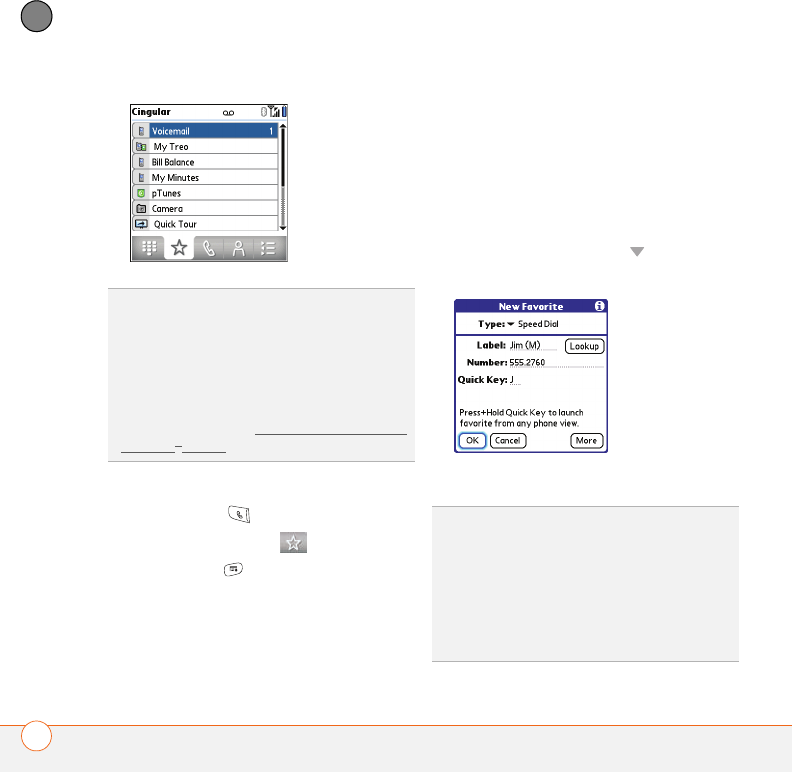
YOUR PHONE
62
3
CHAPTER
Creating a speed-dial favorite button
1Press Phone .
2Select the Favorites tab.
3Press Menu .
4Select New Favorite on the Record
menu.
5Enter a label for the favorite:
•If the entry is for an existing contact,
select Lookup. Start entering the last
name of the contact, and select the
contact when it appears in the lookup
list.
•If the entry is for a new contact, enter
the label, press Down , and enter
the number.
6(Optional) Enter a Quick Key.
DID
YOU
KNOW
?
If you’re upgrading from a Treo
600/650, most of your favorites should
transfer from your old Treo along with your
other info. However, you may need to
rearrange the order in which your favorites
appear by opening the Record menu and then
selecting Organize Favorites. For more info
about upgrading, see Upgrading from another
Palm OS®device.
KEY
TERM
Quick Key A letter that you can
press and hold to activate a favorite from any
tab in the Phone app. For example, create a
speed-dial button for your mother’s number
and enter the letter M for “Mom” as the
Quick Key. Then when you want to call her, go
to the Phone app and press and hold M. Your
Treo 680 dials the number.

YOUR PHONE
63
3
CHAPTER
7(Optional) Select More, and then select
advanced options:
Extra Digits: Defines additional digits to
dial, such as a password or extension.
To enter a one-second pause, insert a ,
(comma) between digits. To add a
longer pause, either enter more
commas, or enter a p to add a 3-second
pause.
Dial Extra Digits Automatically: Dials
predefined extra digits immediately
after dialing the phone number, when
checked.
8Select OK.
Creating other types of favorite buttons
1Press Phone .
2Select the Favorites tab.
3Press Menu .
4Select New Favorite on the Record
menu.
5Select the Ty p e pick list and select
Application, Message, Email, or Web
Link.
6Enter a label for the favorite and enter
any other necessary information on
the screen.
7(Optional) Enter a Quick Key.
8Select OK.
Editing a favorite button
1Press Phone .
2Select the Favorites tab.
3Highlight the favorite button you want to
edit.
4Press Menu .
5Select Edit Favorite on the Record
menu.
6After you make your changes, select
OK.
DID
YOU
KNOW
?
You can assign a special
ringtone for a contact. See Assigning a caller
ID ringtone for details.
DID
YOU
KNOW
?
When creating a Message or
Email favorite, you can enter multiple
addresses; simply separate each address with
a comma. This is an easy way to send
messages to a group of people.
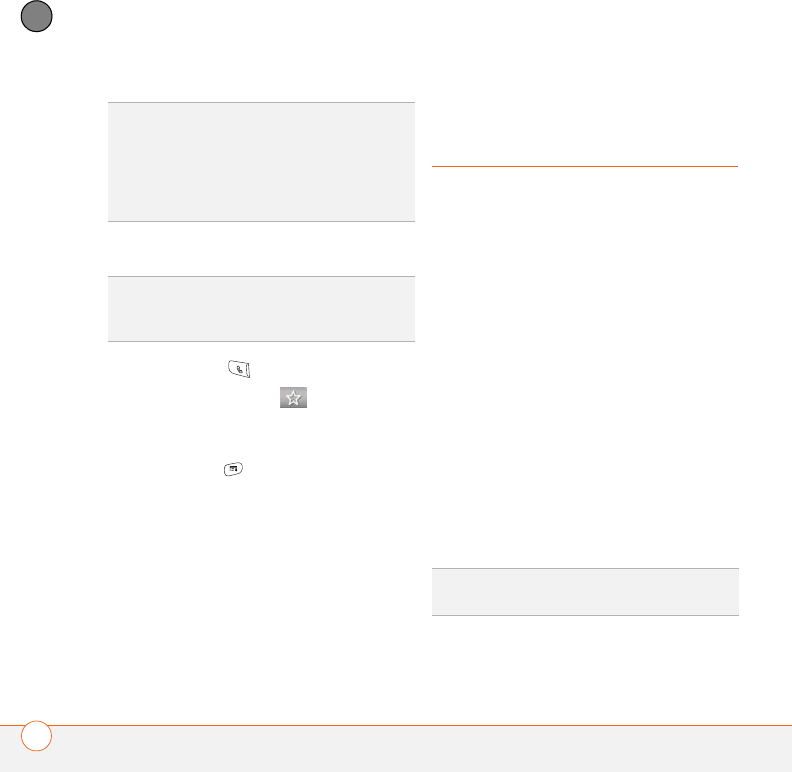
YOUR PHONE
64
3
CHAPTER
Deleting a favorite button
1Press Phone .
2Select the Favorites tab.
3Highlight the favorite button you want to
delete.
4Press Menu .
5Select Edit Favorite on the Record
menu.
6Select Delete.
7Select OK.
Using a hands-free
device
If you need to use your phone while driving
and this is safe and permitted in your area,
use a phone headset (wired headset
included) or car kit (sold separately) for
hands-free operation. Using a hands-free
device also makes it easy to check your
calendar, look up contact info, take notes,
and use other features during a call.
In addition to the headset included with
your Treo, your Treo is compatible with the
following types of hands-free devices that
are sold separately:
•Wired headsets and car kits with a
2.5mm connector (3-pin or 4-pin)
•Wireless headsets and car kits enabled
with Bluetooth 1.1 or 1.2 wireless
technology
Check the specifications for your
hands-free device to confirm compatibility.
TIP
To arrange your favorites, open the Record
menu and select Organize Favorites.
Highlight the favorite you want to move, and
then press and hold Option + Up or Down to
move the button to another position. Select
Done.
TIP
Some favorites, such as voicemail, cannot
be deleted. If a favorite can’t be deleted, the
Delete button does not appear on the screen.
TIP
The headset designed for Treo 180/270/
300 is not compatible with your Treo 680.
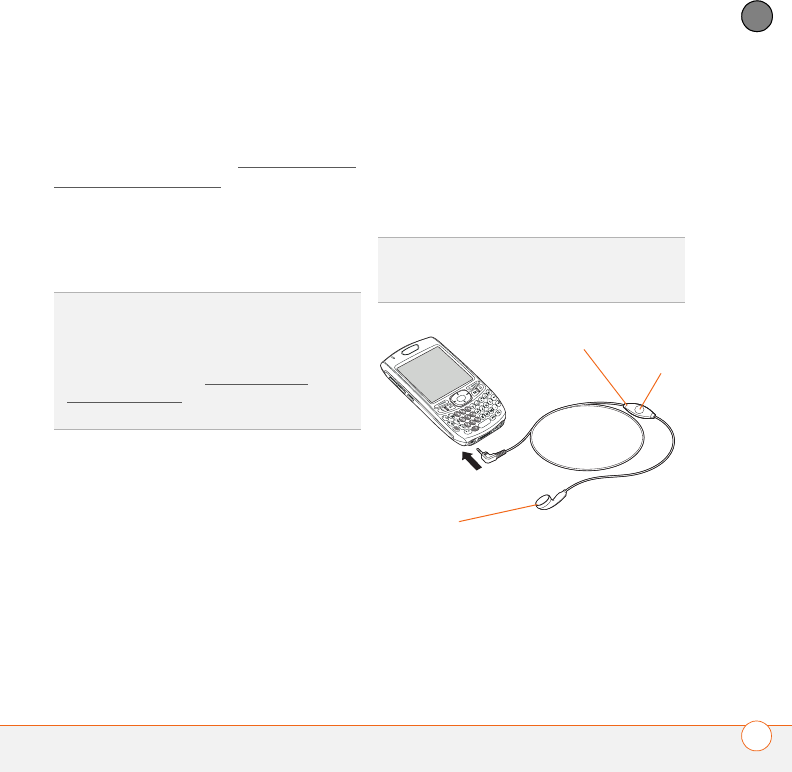
YOUR PHONE
65
3
CHAPTER
When in doubt, ask the manufacturer if the
product is compatible with your Treo 680.
To view a list of compatible Bluetooth
hands-free devices, go to www.palm.com/
treo680cingular-support.
NOTE You cannot use a hands-free device
with Bluetooth wireless technology to
listen to music files.
Using a wired headset
When using the headset that is included
with your Treo 680, you can press the
headset button to perform any of the
following tasks:
•Answer an incoming call
•Answer a call-waiting call
•Resume a call that you put on hold (not
available when multiple calls are in
progress)
•Swap between two calls (one on hold
and one active)
•Hang up the active call
TIP
To listen to music in stereo, you can
purchase the Palm 2-in-1 Stereo Headset. If
you want to use a stereo headset with a
3.5mm connector, then you need to purchase
a stereo adapter. Visit www.palm.com/
mytreo680cingular for more info on audio
accessories.
TIP
On other headsets, the headset button
may work differently than the button on the
headset included with your Treo 680.
Headset
button
Microphone
Speaker
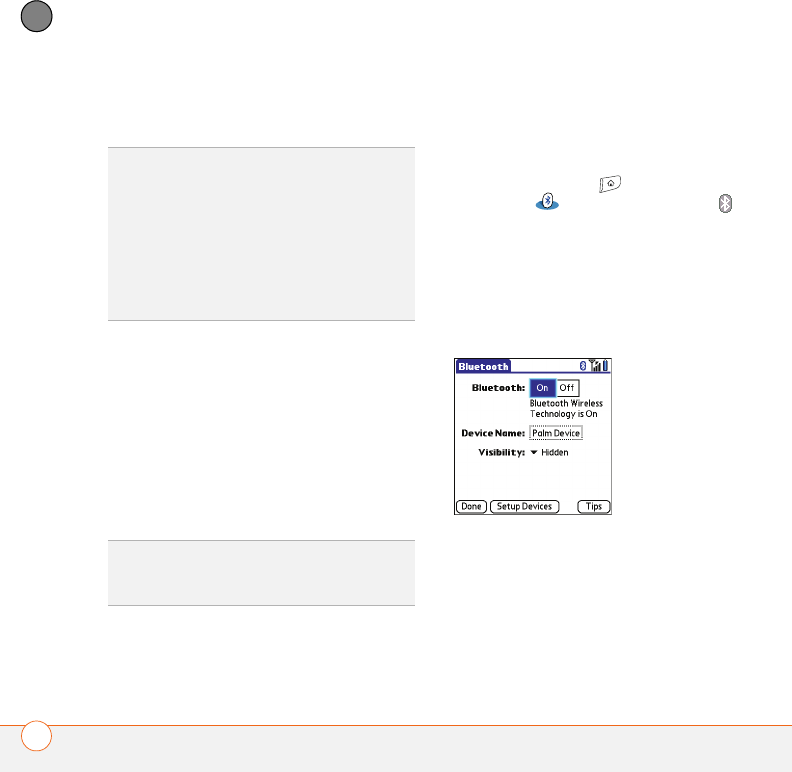
YOUR PHONE
66
3
CHAPTER
Connecting to a Bluetooth hands-free
device
Once you set up a partnership with a
Bluetooth hands-free device, you can
communicate with that device whenever it
is turned on and within range. Bluetooth
range is up to 30 feet in optimum
environmental conditions. Performance
and range may be reduced by physical
obstacles, radio interference from nearby
electronic equipment, and other factors.
BEFORE YOU BEGIN Prepare your
hands-free device to accept a connection
from another Bluetooth device. See the
documentation that came with your
hands-free device for instructions.
1Press Applications and select
Bluetooth or tap the Bluetooth
icon in the title bar.
2Select Bluetooth On.
NOTE The Bluetooth icon changes from
gray to blue to let you know that Bluetooth
technology is turned on.
3(Optional) Enter a device name that
identifies your Treo 680 when it is
discovered by other Bluetooth devices.
NOTE Use the same device name for all
your Bluetooth connections. If you change
the device name, you need to recreate any
partnerships you already created.
KEY
TERM
Partnership Two devices—for
example, your Treo 680 and a hands-free
device—that can connect because each
device finds the same passkey on the other
device. Once you form a partnership with a
device, you don’t need to enter a passkey to
connect with that device again. Partnership is
also known as paired relationship, pairing,
trusted device, and trusted pair.
TIP
If you hear a headset buzz or experience
poor microphone performance, your headset
may be incompatible with your Treo 680.
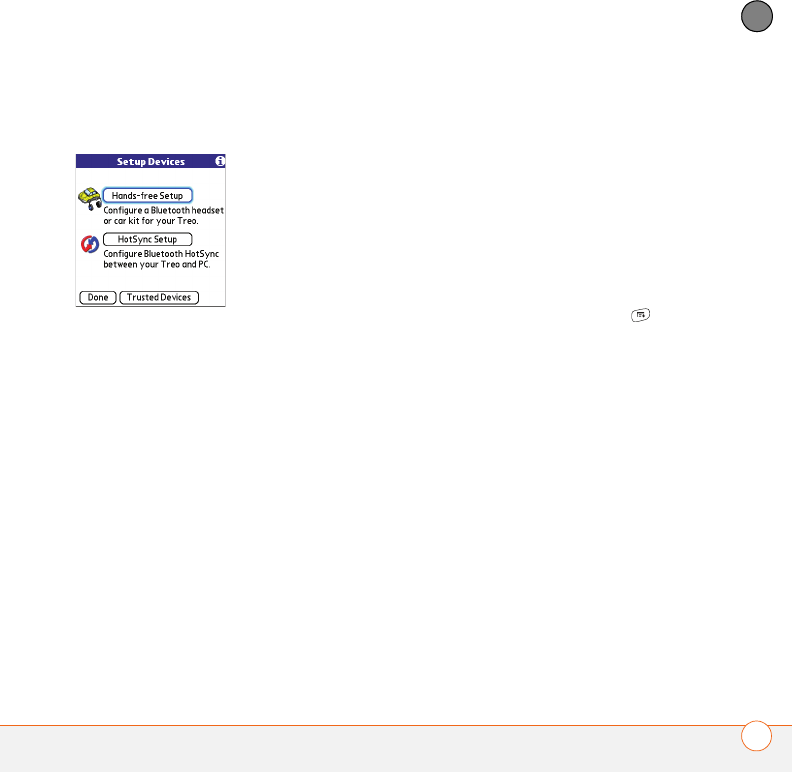
YOUR PHONE
67
3
CHAPTER
4Select Setup Devices.
5Select Hands-free Setup.
6Follow the onscreen instructions to
create a partnership with the specific
hands-free device. When prompted,
enter a passkey.
IMPORTANT Some hands-free devices
have a predefined passkey; if so, you can
find the passkey in the documentation for
that device. Other devices provide a screen
where you enter a passkey that you make
up. In either case, you must use the same
passkey on both your Treo 680 and your
hands-free device. We recommend that
where possible, you make up a passkey of
16 alphanumeric characters (letters and
numerals only) to improve the security of
your Treo 680. The longer the passkey, the
more difficult it is for the passkey to be
deciphered.
7After you finish setting up the device,
select Done to return to Trusted
Devices View.
NOTE For some car kits, you need to
initiate a Bluetooth connection from your
Treo 680 to complete the partnership
process. To do this, highlight the car kit in
Trusted Devices View, press Menu ,
and then select Connect.
8(Optional) Enable advanced hands-free
features by pressing the multifunction
button (MFB) on the hands-free device.
You can tell the connection is successful
when you see a light blue headset icon in
the title bar of the Phone application. You
can now use your Treo 680 with the
Bluetooth hands-free device.
Using a Bluetooth hands-free device
After you create a partnership with your
Bluetooth hands-free device and you turn it
on within range (up to 30 feet), the Treo
automatically routes all calls to the
hands-free device instead of to the

YOUR PHONE
68
3
CHAPTER
earpiece on your Treo. When a call comes
in, your Treo 680 rings and the hands-free
device beeps. Even if you answer the call
on your Treo, the call goes to the
hands-free device. If you prefer to route
calls to the earpiece on your Treo, you can
change the settings on your Treo 680 to do
this; see Customizing advanced settings
for your hands-free device for details.
The features of your hands-free device vary
by model. Check the documentation for
your hands-free device for details about
these features. Your Treo 680 can support
the following actions, provided that your
hands-free device also supports them:
•Answer an incoming call
•Hang up a call and answer a call-waiting
call
•Place a call on hold and answer a
call-waiting call
•Hang up a single call
•Transfer an outgoing call from the
earpiece on your Treo to the hands-free
device
•Ignore an incoming call
•Redial the last number you called from
the hands-free device
Customizing advanced settings for your
hands-free device
You can set whether your hands-free
device automatically answer calls, provided
the device supports this feature.
1Press Applications and select
Prefs .
2Select Hands-free.
TIP
If you’re using a Bluetooth hands-free
device and you want to return to the earpiece
or a wired headset during a call, select Cancel
Bluetooth in Active Call View. To return the
call to the hands-free device, open the
Options menu and select Connect
Bluetooth.
DID
YOU
KNOW
?
If you have more than one
Bluetooth hands-free device, the last one you
connected to becomes the active device. To
switch between devices, turn off the active
device before you try to connect to the other
device.

YOUR PHONE
69
3
CHAPTER
3Do one of the following:
To send all calls to your hands-free
device: Check the Always route calls
to handsfree box. Select the Auto
answer pick list and select whether you
want your hands-free device to
automatically answer incoming calls and
how quickly it answers.
To choose between the earpiece on
your Treo and your hands-free device
on a call-by-call basis: Uncheck the
Always route calls to handsfree box.
When the phone rings, you can answer
the call with your hands-free device by
pressing the multifunction button on
your hands-free device, or you can
answer the call with the earpiece on
your Treo by using the controls on your
Treo 680 (see Receiving calls).
4Select Done.
Customizing phone
settings
Selecting ringtones
You can set various tones for various types
of incoming calls.
1Press Phone .
2Press Menu .
3Select Options, and then select Sound
Preferences.
4Select the Application pick list and
select Ring Tones.
DID
YOU
KNOW
?
You can download any
compatible ringtone directly to your Treo 680
(see Downloading files from a web page). You
can also download ringtones to your computer
and then email them to your Treo 680.
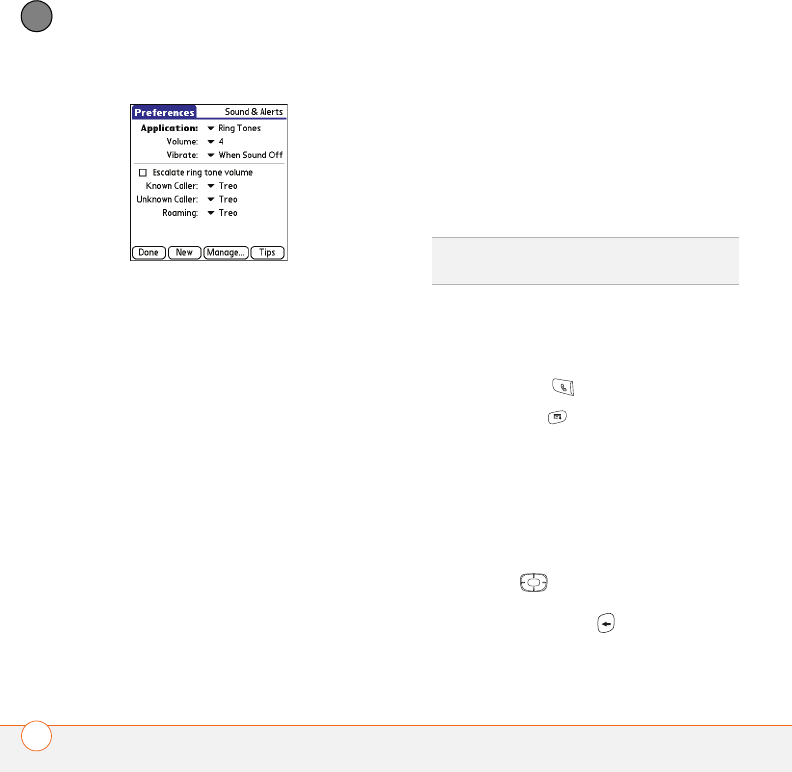
YOUR PHONE
70
3
CHAPTER
5Select the Volume pick list and select
the volume level.
6Select the Vibrate pick list and select
when you want your Treo 680 to vibrate
for an incoming call.
7(Optional) Check the Escalate ring
tone volume box if you want the ring to
play softly and then increase to full
volume the longer it rings.
8Select a ringtone from the pick list to
identify each of the following:
Known Caller: An incoming call from
someone in your Contacts or Favorites.
Unknown Caller: An incoming call from
someone identified by caller ID who is
not in your Contacts or Favorites. This
includes callers that have blocked their
caller ID.
Roaming: A special tone for incoming
calls when you’re outside your home
mobile network. This tone overrides all
other ringtones, unless you select No
Sound.
9Select Done.
Creating and managing ringtones
You can also record sounds and use them
as ringtones.
1Press Phone .
2Press Menu .
3Select Options, and then select Sound
Preferences.
4Select Manage.
5Do one of the following:
•To record a sound, select New.
•To play a sound, select it with the
5-way .
•To delete a sound, highlight it and
press Backspace .
DID
YOU
KNOW
?
You can assign a ringtone to a
contact or an entire category of contacts.
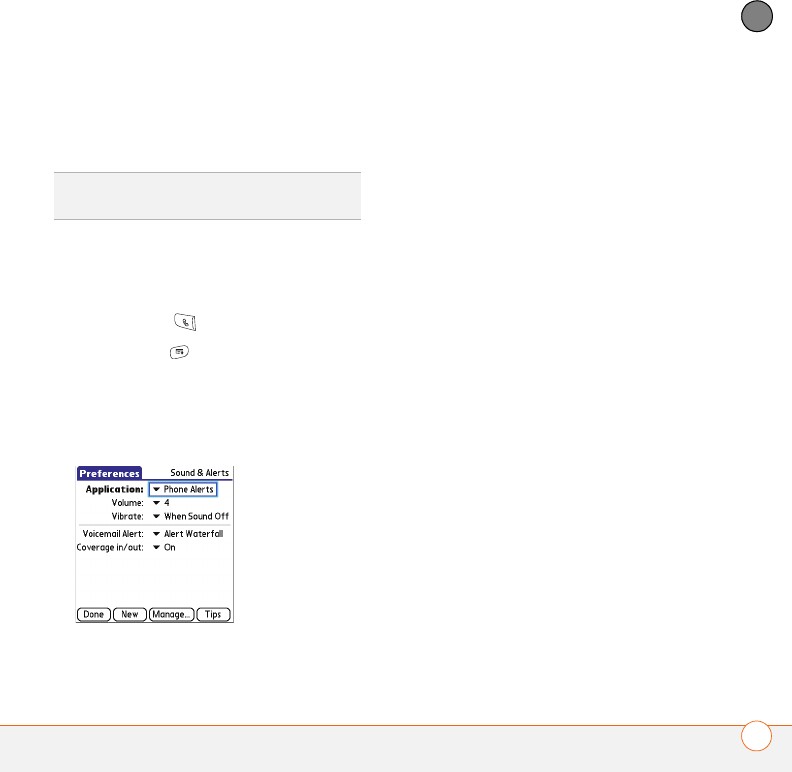
YOUR PHONE
71
3
CHAPTER
•To send a sound, highlight it and
select Send.
6Select Done twice.
Selecting Phone alert tones
You can set various tones for various types
of alerts.
1Press Phone .
2Press Menu .
3Select Options, and then select Sound
Preferences.
4Select the Application pick list and
select Phone Alerts.
5Select the Volume pick list and select
the volume level.
6Select the Vibrate pick list and select
when you want your Treo 680 to vibrate
for a phone alert.
7Select an alert tone from the pick list for
each of the following:
Voicemail Alert: Plays when you have
new voicemail.
Coverage in/out: Plays when you move
into or out of a coverage area.
8Select Done.
Adjusting call volume
While a call is in progress, press the
Volume button on the side of your Treo to
adjust the call volume.
•To increase the volume, press the upper
half of the Volu me button.
•To decrease the volume, press the
lower half of the Volum e button.
TIP
You can also create a new sound by
selecting New in Sound & Alerts Preferences.
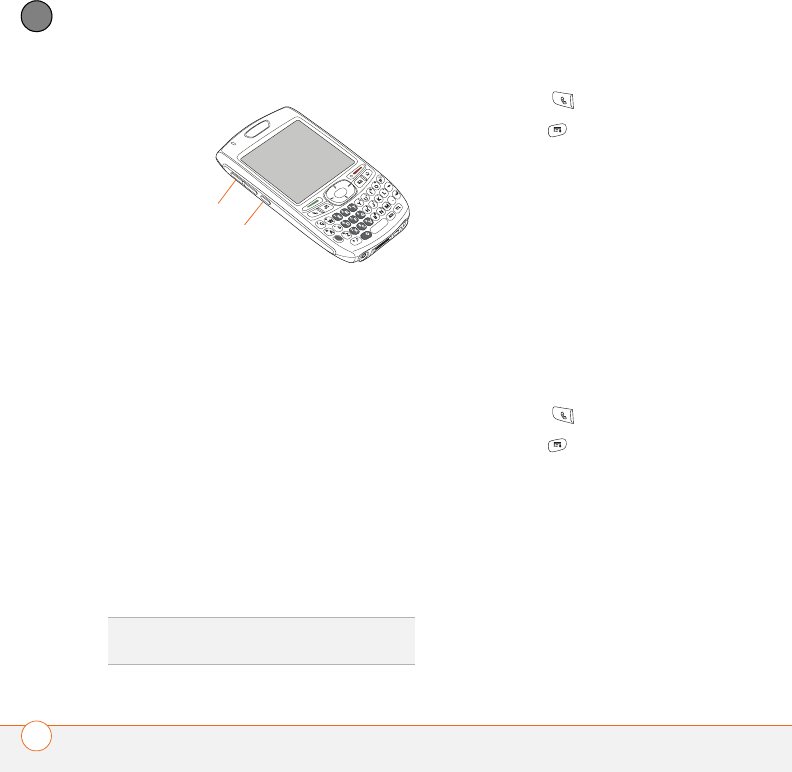
YOUR PHONE
72
3
CHAPTER
Adjusting ringer volume
When a call is not in progress and music is
not playing, press the Volum e button on
the side of your Treo to adjust ringer
volume, and then press the Side button to
confirm your selection.
Barring calls
Call Barring lets you prevent unauthorized
calls on your Treo 680. You must enter your
Call Barring password every time you
change your Call Barring preferences.
Contact Cingular Wireless if you do not
know this password or if you need more
information.
1Press Phone .
2Press Menu .
3Select Options, and then select Call
Barring.
4Select the Outgoing and Incoming pick
lists, and then select the type of calls
you want to prevent.
5Select OK.
Customizing the Main tab in the Phone
application
Phone Display Options let you customize
the appearance and entry mode of the
Main tab in the Phone application.
1Press Phone .
2Press Menu .
3Select Options, and then select Phone
Display Options.
4Set any of the following options:
Wallpaper: Sets the wallpaper that
appears on the Main tab in the Phone
application. To change the wallpaper,
select the thumbnail image and then
select an image to use as wallpaper.
TIP
Call barring may not be available in some
areas.
Volume
Side button
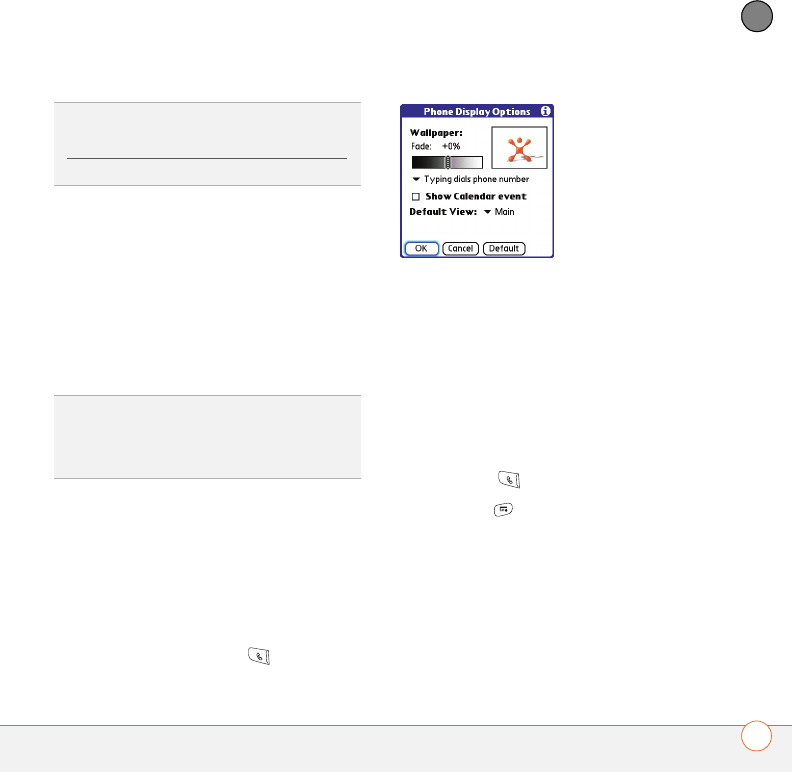
YOUR PHONE
73
3
CHAPTER
Fade: Adjusts the intensity level of the
wallpaper image.
Ty p i n g … : Sets whether typing in the
Main tab in the Phone app displays the
Dial Pad and enters numbers you want
to dial, or whether it displays the
Contacts tab and starts a contacts
search.
Show Calendar event: Sets whether
the current event from the Calendar
application appears in the Main tab in
the Phone app. When this option is
enabled, you can then select this event
to jump to the Calendar app.
Default View: Sets the tab that appears
when you press Phone .
5Select OK.
Setting your dialing preferences
Dialing preferences let you assign a prefix
to your phone numbers. For example, you
can automatically dial a 1 before all 10-digit
phone numbers. You can add a different
prefix based on the length of the phone
number.
1Press Phone .
2Press Menu .
3Select Options, and then select Dial
Preferences.
4Set any of the following options:
Dialing from North America: Formats
phone numbers using North American
conventions (XXX-XXX-XXXX).
DID
YOU
KNOW
?
You can also set the
background for Calendar Agenda View. See
Customizing display options for your calendar
for details.
TIP
If you select the Typing starts contacts
search option, you can still enter a phone
number from the Main tab in the Phone app
by pressing Option followed by the number.
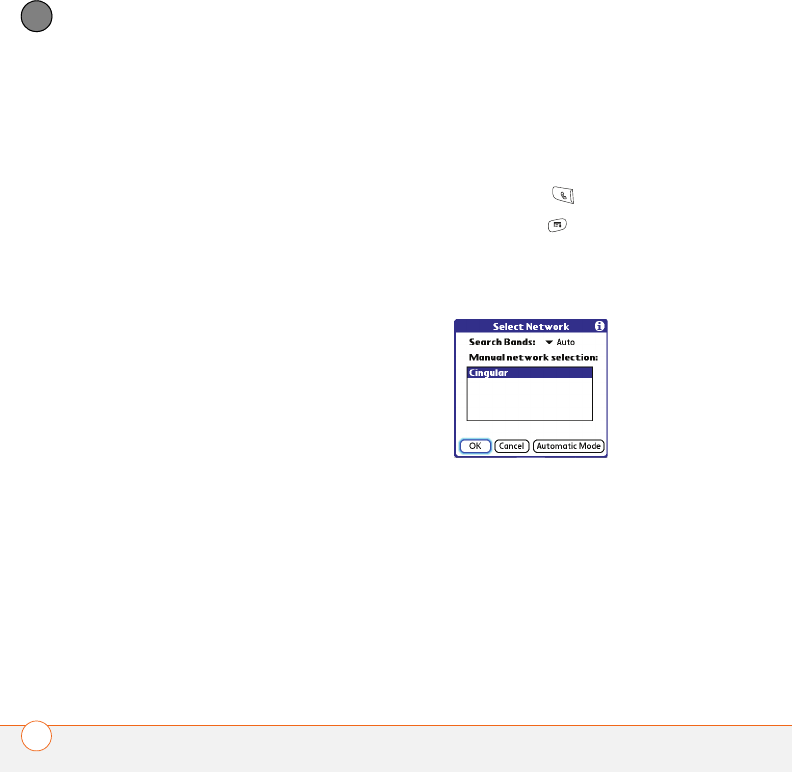
YOUR PHONE
74
3
CHAPTER
Always dial +1 in front of the area
code: Adds a 1 in front of 10-digit phone
numbers. This option is available only
when Dialing from North America is
enabled.
To 7 digit numbers: Adds a prefix to
7-digit numbers. For example, enter
your own area code to automatically add
your area code when you dial local
numbers.
To (6), (5), (4), digit numbers: Adds a
prefix to numbers with the specified
number of digits. For example, if all the
phone numbers in your office have the
408 area code and a 555 exchange,
followed by a 4-digit extension, select 4
and enter the prefix 408555. To call a
colleague, simply dial your colleague’s
4-digit extension; your Treo 680
automatically dials the rest and makes
the call. You can also create contact
entries with just the extension number
and then dial the number from your
Contacts list.
5Select OK.
Manually selecting the wireless network
When travelling outside the US, you may
be able to search for other wireless
network services in your current location.
1Press Phone .
2Press Menu .
3Select Select Network from the
Options menu.
4Select another network, if available.
5Select OK.
Using TTY
A TTY (also known as TDD or text
telephone) is a telecommunications device
that allows people who are deaf or hard of
hearing, or who have speech or language
disabilities, to communicate by telephone.